employee selection
人力资源六大模块分类
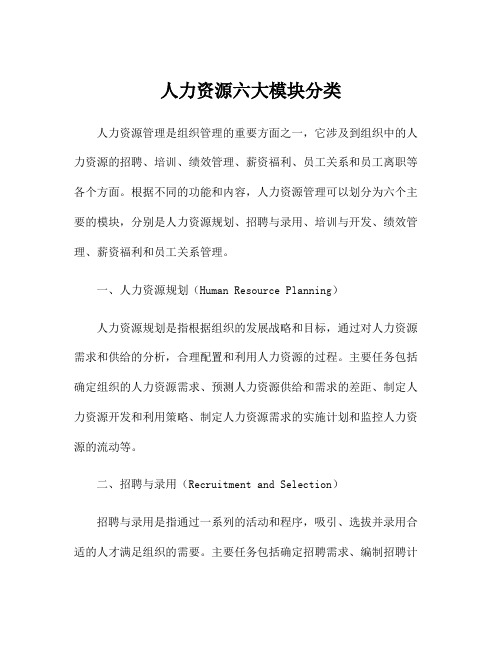
人力资源六大模块分类人力资源管理是组织管理的重要方面之一,它涉及到组织中的人力资源的招聘、培训、绩效管理、薪资福利、员工关系和员工离职等各个方面。
根据不同的功能和内容,人力资源管理可以划分为六个主要的模块,分别是人力资源规划、招聘与录用、培训与开发、绩效管理、薪资福利和员工关系管理。
一、人力资源规划(Human Resource Planning)人力资源规划是指根据组织的发展战略和目标,通过对人力资源需求和供给的分析,合理配置和利用人力资源的过程。
主要任务包括确定组织的人力资源需求、预测人力资源供给和需求的差距、制定人力资源开发和利用策略、制定人力资源需求的实施计划和监控人力资源的流动等。
二、招聘与录用(Recruitment and Selection)招聘与录用是指通过一系列的活动和程序,吸引、选拔并录用合适的人才满足组织的需要。
主要任务包括确定招聘需求、编制招聘计划、发布招聘广告、筛选简历、面试、进行背景调查、制定录用计划等。
三、培训与开发(Training and Development)培训与开发是指通过不同的培训和发展活动,提高员工的能力、知识和技能,从而帮助他们更好地适应组织的需求和变化。
主要任务包括制定培训需求分析、制定培训计划、组织培训活动、评估培训效果等。
四、绩效管理(Performance Management)绩效管理是指通过制定目标、评估绩效、提供反馈和奖惩措施,帮助员工提高工作绩效和个人发展的过程。
主要任务包括制定绩效管理体系、设定绩效指标、进行绩效评估、提供绩效反馈、制定绩效奖励和处罚等。
五、薪资福利(Compensation and Benefits)薪资福利是指组织为员工提供的薪资和各种福利待遇,包括工资、奖金、津贴、福利计划等。
主要任务包括进行薪资调查、制定薪资政策、设计薪资福利体系、制定薪资福利计划等。
六、员工关系管理(Employee Relations Management)员工关系管理是指通过与员工建立良好的关系,解决员工的问题和满足员工的需求,维护良好的劳动关系和组织的稳定。
公司部门英文缩写简称大全

公司部门英文缩写简称大全Yesterday disappeared, January 6, 2020公司部门英文缩写简称大全 1资材:logistics营运:operation资材营运部:logistics operation department总公司H e a d O f f i c e分公司B r a n c h O f f i c e营业部B u si n e ss O f f i c e人事部P e r so n n e l D e p a r t m e n t人力资源部H u m a n R e s o u r c e s D e p a r t m e n t总务部G e n e r a l A f f a i r s D e p a r t m e n t财务部G e n e r a l A c c o u n t i n g D e p a r t m e n t销售部S a l e s D e p a r t m e n t促销部S a l e s Pr o m o t i o n D e p a r t m e n t国际部I n t e r n a t i o n a l D e p a r t m e n t出口部E x p o r t D e p a r t m e n t进口部I m p o r t D e p a r t m e n t公共关系Pu b l i c R e l a t i o n s D e p a r t m e n t广告部A d ve r t i si n g D e p a r t m e n t企划部P l a n n i n g D e p a r t m e n t产品开发部P r o d u c t D e ve l o p m e n t D e p a r t m e n t研发部R e se a r c h a n d D e ve l o p m e n t D e p a r t m e n t R&D秘书室S e c r e t a r i a l Po o l采购部P u r c h a s i n g D e p a r t m e n t工程部E n g i n e e r i n g D e p a r t m e n t行政部A d m i n.D e p a r t m e n t人力资源部H R D e p a r t m e n t市场部Ma r k e t i n g D e p a r t m e n t技术部T e c h n o l o g D e p a r t m e n t客服部S e r vi c e D e p a r t m e n t行政部:A d m i n i st r a t i o n财务部F i n a n c i a l D e p a r t m e n t总经理室、D i r e c o t o r,o r Pr e si d e n t副总经理室、D e p u t y D i r e c t o r,o r V i c e p r e s i d e n t总经办、G e n e r a l D e p a r m e n t采购部、P u r c h a se& O r d e r D e p a r t m e n t工程部、E n gi n e e r i n g D e p a r m e n t研发部、R e se a r c h D e p a r m e n t生产部、P r o d u c t i v e D e p a r t m e n t销售部、S a l e s D e p a r m e n t广东业务部、G D B r a n c h D e p a r m e n t无线事业部、Wi r e l e s s I n d u s t r y D e p a r t m e n t拓展部B u si n e ss E x p e n d i n g D e p a r t m e n t物供部、S u p p l y D e p a r t m e n tB&D b u si n e s s a n d d e v e l o p m e n t业务拓展部M a r k e t i n g市场部S a l e s 销售部H R人力资源部A c c o u n t会计部P R p e o p l e r e l a t i o n sh i p公共关系部O FC O f f i c e,但不常见/O M B=O f f i c e o f M a n a g e m e n t a n d B u d ge t 办公室F i n a n c e财务部M K T G Ma r k e t i n g市场部R&D R e se a r c h&D e v e l o p m e n t研发部M F G Ma n u f a c t u r i n g产品部A d m i n i st r a t i o n D e p t.管理部P u r c h a si n g D e p t采购部C h a i r m a n/P r e si d e n t O f f i c e//G e r n e r a l M a n a g e r o f f i c e o r G M o f f i c e 总经理办公室M o n i t o r&S u p p o r t D e p a r t m e n t监事会S t r a t e g y R e se a r c h战略研究部我认为翻译没有标准答案,要根据实际情况来进行决定;有时候同一个部门,在你们厂和我们公司它的叫法就是不一样;在美国和英国或新西兰它也不一样;等等;例如党支部,在英语国家没有这个玩意,你翻得再好,也只是自己的创造;创造得再好,外国人看了一样不懂,一样需要你的解释;外销部:O ve r se a s D e p a r t m e n t,I n t e r n a t i o n a l S a l e s S e c t i o n,E x p o r t S e c t i o n财务科:Fi n a n c i a l/Fi s c a l D e p a r t m e n t党支部:C o m m u n i st P a r t y O f f i c e会议室:Me e t i n g R o o m/H a l l/A u d i t o r i u m,或C o n f e r e n c e H a l l/A u d i t o r i u m或直接A u d i t o r i u m,视其大小而定了;会客室:R e c e p t i o n Lo u n g e/R o o m/H o u s e,或Me e t i n g R o o m或G u e s t R o o m质检科:B a c k-c h e c k Se c t i o n/D e p a r t m e n t,Q u a l i t y-i n s p e c t i o n/Q u a l i t y C o n t r o l D e p a r t m e n t内销部:D o m e st i c Sa l e s Se c t i o n/D e p a r t m e n t厂长室:Mi l l e r/D i r e c t o r/Pr e s i d e n t'O f f i c e这很取决於你们厂的类型和规模行政科:A d m i n i st r a t i o n Se c t i o n/D e p a r t m e n t,S e r v i c e s e c t i o n技术部:T e c h n o l o g y S e c t i o n档案室:A r c h i ve s O f f i c e生产科:Pr o d u c t i o n/Pr o c e s si n g S e c t i o n一句话,不管选哪个,都得与自己公司或工厂的规模,类型,性质和结构相适应;外销部:E X P O R T D E PA R T M E N T财务科:FI N A N C IA L D E PA R T M E N T党支部:B R A N C H O F T H E P A R T Y会议室:ME E T I N G R O O M会客室:R E C E PT IO N R O O M质检科:Q U A LI T Y T E ST I N G D E P A R T M E N T内销部:D O ME ST IC SA LE S D E P A R T M E N T厂长室:FA C T O R Y D I R E C T O R'S R O O M行政科:A D M I N I ST R A T I O N D E P A R T M E N T技术部:T E C H N O L O G Y SE C T I O N档案室:MU N I ME N T R O O M生产科:MA N U FA C T U R E S E C T I O N一、人力资源管理:H u m a n R e s o u r c e Ma n a g e m e n t,H R M人力资源经理:h u m a n r e s o u r c e m a n a ge r高级管理人员:e x e c u t i v e/i`g z e k j u t i v职业:p r o fe s si o n道德标准:e t h i c s操作工:o p e r a t i v e e m p l o ye e s专家:sp e c i a l i st人力资源认证协会:t h e H u m a n R e s o u r c e C e r t i fi c a t i o n I n s t i t u t e,H R C I 二、外部环境:e x t e r n a l e n v i r o n m e n t内部环境:i n t e r n a l e n v i r o n m e n t政策:p o l i c y企业文化:c o r p o r a t e c u l t u r e目标:m i s si o n股东:sh a r e h o l d e r s非正式组织:i n f o r m a l o r g a n i z a t i o n跨国公司:m u l t i n a t i o n a l c o r p o r a t i o n,M N C管理多样性:m a n a gi n g d i ve r s i t y三、工作:j o b职位:p o st i n g工作分析:j o b a n a l ys i s工作说明:j o b d e sc r i p t i o n工作规范:j o b s p e c i fi c a t i o n工作分析计划表:j o b a n a l ys i s s c h e d u l e,J A S职位分析问卷调查法:M a n a g e m e n t P o s i t i o n D e s c r i p t i o n Q u e st i o n n a i r e,M P D Q行政秘书:e x e c u t i v e se c r e t a r y地区服务经理助理:a s s i st a n t d i s t r i c t s e r v i c e m a n a ge r四、人力资源计划:H u m a n R e s o u r c e Pl a n n i n g,H R P战略规划:st r a t e gi c p l a n n i n g长期趋势:l o n g t e r m t r e n d要求预测:r e q u i r e m e n t f o r e c a s t供给预测:a va i l a b i l i t y f o r e c a s t管理人力储备:m a n a g e m e n t i n v e n t o r y裁减:d o w n si zi n g人力资源信息系统:H u m a n R e s o u r c e I n fo r m a t i o n S ys t e m,H R I S五、招聘:r e c r u i t m e n t员工申请表:e m p l o y e e r e q u i s i t i o n招聘方法:r e c r u i t m e n t m e t h o d s内部提升:Pr o m o t i o n Fr o m Wi t h i n,P F W工作公告:j o b p o st i n g广告:a d ve r t i si n g职业介绍所:e m p l o y m e n t a g e n c y特殊事件:sp e c i a l e v e n t s实习:i n t e r n sh i p六、选择:se l e c t i o n选择率:se l e c t i o n r a t e简历:r e su m e标准化:s t a n d a r d i z a t i o n有效性:va l i d i t y客观性:o b j e c t i vi t y规范:n o r m录用分数线:c u t o f f sc o r e准确度:a i m i n g业务知识测试:j o b k n o w l e d g e t e st s求职面试:e m p l o ym e n t i n t e r v i e w非结构化面试:u n st r u c t u r e d i n t e r v i e w 结构化面试:st r u c t u r e d i n t e r v i e w小组面试:g r o u p i n t e r v i e w职业兴趣测试:vo c a t i o n a l i n t e r e s t t e s t s 会议型面试:b o a r d i n t e r v i e w七、组织变化与人力资源开发人力资源开发:H u m a n R e s o u r c e D e ve l o p m e n t,H R D 培训:t r a i n i n g开发:d e ve l o p m e n t定位:o r i e n t a t i o n训练:c o a c h i n g辅导:m e n t o r i n g经营管理策略:b u si n e s s g a m e s案例研究:c a se st u d y会议方法:c o n fe r e n c e m e t h o d角色扮演:r o l e p l a yi n g工作轮换:j o b r o t a t i n g在职培训:o n-t h e-j o b t r a i n i n g ,O J T媒介:m e d i a八、企业文化与组织发展企业文化:c o r p o r a t e c u l t u r e组织发展:o r ga n i za t i o n d e ve l o p m e n t,O D调查反馈:su r ve y f e e d b a c k质量圈:q u a l i t y c i r c l e s目标管理:m a n a ge m e n t b y o b j e c t i ve,M B O全面质量管理:T o t a l Q u a l i t y M a n a g e m e n t,T Q M 团队建设:t e a m b u i l d i n g九、职业计划与发展职业:c a r e e r职业计划:c a r e e r p l a n n i n g职业道路:c a r e e r p a t h职业发展:c a r e e r d e v e l o p m e n t自我评价:se l f-a sse ss m e n t职业动机:c a r e e r a n c h o r s十、绩效评价绩效评价:Pe r f o r m a n c e A p p r a i s a l,P A小组评价:g r o u p a p p r a i sa l业绩评定表:r a t i n g sc a l e s m e t h o d关键事件法:c r i t i c a l i n c i d e n t m e t h o d排列法:r a n k i n g m e t h o d平行比较法:p a i r e d c o m p a r i s o n硬性分布法:f o r c e d d i st r i b u t i o n m e t h o d晕圈错误:h a l o e r r o r宽松:l e n i e n c y严格:st r i c t n e s s3600反馈:360-d e g r e e fe e d b a c k叙述法:e s sa y m e t h o d集中趋势:c e n t r a l t e n d e n c y十一、报酬与福利报酬:c o m p e n s a t i o n直接经济报酬:d i r e c t f i n a n c i a l c o m p e n s a t i o n 间接经济报酬:i n d i r e c t fi n a n c i a l c o m p e n s a t i o n 非经济报酬:n o fi n a n c i a l c o m p e n s a t i o n公平:e q u i t y外部公平:e x t e r n a l e q u i t y内部公平:i n t e r n a l e q u i t y员工公平:e m p l o ye e e q u i t y小组公平:t e a m e q u i t y工资水平领先者:p a y l e a d e r s现行工资率:g o i n g r a t e工资水平居後者:p a y f o l l o w e r s劳动力市场:l a b o r m a r k e t工作评价:j o b e v a l u a t i o n排列法:r a n k i n g m e t h o d分类法:c l a ss i fi c a t i o n m e t h o d因素比较法:f a c t o r c o m p a r i s o n m e t h o d评分法:p o i n t m e t h o d海氏指示图表个人能力分析法:H a y G u i d e C h a r t-p r o fi l e M e t h o d 工作定价:j o b p r i c i n g工资等级:p a y g r a d e工资曲线:w a ge c u r ve工资幅度:p a y r a n g e十二、福利和其它报酬问题福利间接经济补偿员工股权计划:e m p l o ye e st o c k o w n e r s h i p p l a n,E S O P值班津贴:sh i f t d i f f e r e n t i a l奖金:i n c e n t i ve c o m p e n sa t i o n分红制:p r o fi t sh a r i n g十三、安全与健康的工作环境安全:sa f e t y健康:h e a l t h频率:f r e q u e n c y r a t e紧张:st r e s s角色冲突:r o l e c o n f l i c t催眠法:h yp n o si s酗酒:a l c o h o l i sm十四、员工和劳动关系工会:u n i o n地方工会:l o c a l u n i o n行业工会:c r a f t u n i o n产业工会:i n d u st r i a l u n i o n全国工会:n a t i o n a l u n i o n谈判组:b a r g a i n i n g u n i o n劳资谈判:c o l l e c t i ve b a r g a i n i n g仲裁:a r b i t r a t i o n罢工:st r i k e内部员工关系:i n t e r n a l e m p l o ye e r e l a t i o n s纪律:d i sc i p l i n e纪律处分:d i sc i p l i n a r y a c t i o n申诉:g r i e v a n c e降职:d e m o t i o n调动:t r a n s f e r晋陞:p r o m o t i o n1、操作工:o p e r a t i ve e m p l o ye e s-我认为o p e r a t i o n s t a f f更符合实际和贴切2、既然提到企业文化,我想加上愿景应该更好-愿景:v i s i o n3、目标:m i s si o n-m i s si o n翻译成使命更好,目标可以是g o a l,没有m i s si o n这种使命感给人感觉更强烈;4、职位:p o st i n g-显然应该是p o s i t i o n5、工作说明:j o b d e sc r i p t i o n-译成职位描述或许更加,H R专业术语中我们称其为J D6、行政秘书:e x e c u t i v e se c r e t a r y-应该是执行秘书,「执行秘书」比一般的「行政秘书」更高一级,基本等同主管级员工;7、地区服务经理助理:a s si s t a n t d i st r i c t s e r v i c e m a n a g e r-这个词组对一般企业来说基本没有意义,应该只是某个特定公司设置的特定职位;8、人力资源计划:H u m a n R e s o u r c e Pl a n n i n g,H R P-译成「人力资源规划」更佳;9、战略规划:st r a t e gi c p l a n n i n g-其实s t r a t e g y一词足以;10、要求预测:r e q u i r e m e n t f o r e c a st-需求预测11、员工申请表:e m p l o ye e r e q u i si t i o n-我认为中英文在这里容易产生歧异:如果是部门需要招聘,需填写招聘申请表r e c r u i t i n g a p p l i c a t i o n f o r m;如果是应聘者应聘填写的表格,通常的称谓是j o b a p p l i c a t i o n f o r m;这里的「员工申请表:e m p l o ye e r e q u i s i t i o n」我不太明白是何种情况;12、试用期应该是很多企业用到的名词,我添加一下p r o b a t i o n;13、加上「辅导」一词c o a c h i n g,很常用的;14、经营管理策略:b u si n e ss ga m e s-ga m e s如果是s t r a t e g y会更专业;15、角色扮演:r o l e p l a yi n g-不要说语法了,就应该是r o l e p l a y,没有i n g,r o l e p l a y这里就是名词一个;16、工作轮换:j o b r o t a t i n g-j o b r o t a t i o n;17、质量圈:q u a l i t y c i r c l e s-品质圈,或品管圈,这样更贴切-在任何企业中,品质的含义都比质量更高;18、职业动机:c a r e e r a n c h o r s-中文极不准确,应该是「职业锚」,完全是两码事;19、报酬:c o m p e n sa t i o n-译成薪酬更好;20、奖金:i n c e n t i v e c o m p e n sa t i o n-i n c e n t i ve足以;21、加一个常用词,年终奖a n n u a l b o n u s;22、工会:u n i o n-当然是l a b o r u n i o n了,没有l a b o r就没有任何意义;。
Job Description for an Employment Assistant
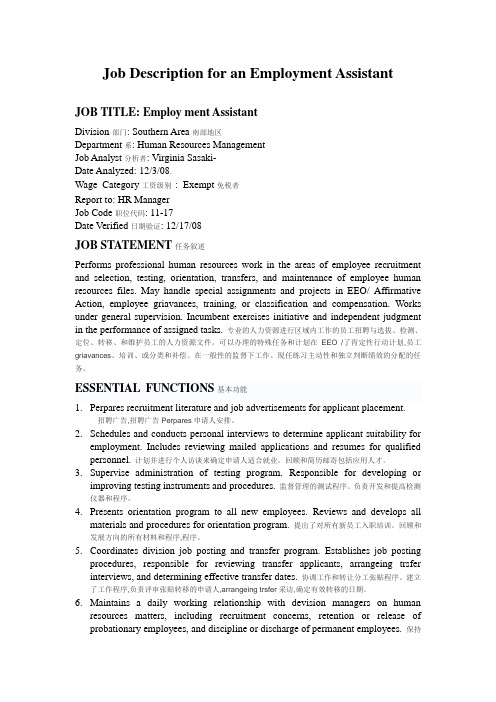
Job Description for an Employment AssistantJOB TITLE: Employ ment AssistantDivision部门: Southern Area南部地区Department系: Human Resources ManagementJob Analyst分析者: Virginia Sasaki-Date Analyzed: 12/3/08.Wage Category工资级别: Exempt免税者Report to: HR ManagerJob Code职位代码: 11-17Date Verified日期验证: 12/17/08JOB STATEMENT任务叙述Performs professional human resources work in the areas of employee recruitment and selection, testing, orientation, transfers, and maintenance of employee human resources files. May handle special assignments and projects in EEO/ Affirmative Action, employee griavances, training, or classification and compensation. Works under general supervision. Incumbent exercises initiative and independent judgment in the performance of assigned tasks.专业的人力资源进行区域内工作的员工招聘与选拔、检测、定位、转移、和维护员工的人力资源文件。
可以办理的特殊任务和计划在EEO /了肯定性行动计划,员工griavances、培训、或分类和补偿。
人力资源管理专业英语词汇100个
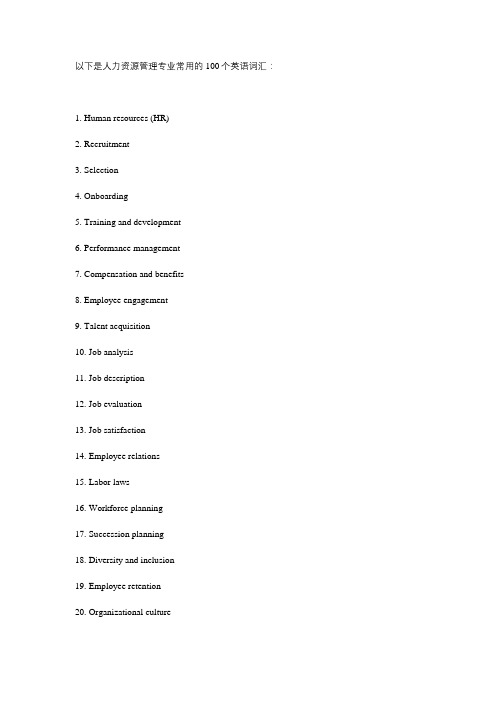
以下是人力资源管理专业常用的100个英语词汇:1. Human resources (HR)2. Recruitment3. Selection4. Onboarding5. Training and development6. Performance management7. Compensation and benefits8. Employee engagement9. Talent acquisition10. Job analysis11. Job description12. Job evaluation13. Job satisfaction14. Employee relations15. Labor laws16. Workforce planning17. Succession planning18. Diversity and inclusion19. Employee retention20. Organizational culture21. Leadership development22. Employee motivation23. Performance appraisal24. Grievance handling25. Work-life balance26. Employee wellness27. Conflict resolution28. HR policies29. HR strategy30. HR metrics31. Talent management32. Compensation structure33. Benefits package34. Employee handbook35. HRIS (Human Resources Information System)36. Employee orientation37. HR compliance38. Employer branding39. HR analytics40. Employee empowerment41. Workforce diversity42. Equal employment opportunity43. Employee turnover44. HR outsourcing45. Talent development46. HR budgeting47. HR consulting48. Job satisfaction survey49. Employee recognition50. Employee performance51. Employee morale52. HR planning53. HR development54. Employee productivity55. Employee grievance56. HR audit57. HR administration58. Employee benefits enrollment59. HR communication60. HR leadership61. HR transformation62. HR technology63. HR outsourcing64. Employee engagement survey65. HR ethics66. HR compliance training67. HR best practices68. HR department69. HR manager70. HR specialist71. HR coordinator72. HR assistant73. HR director74. HR consultant75. HR business partner76. HR executive77. HR recruiter78. HR analyst79. HR internship80. HR career development81. HR professional certification82. HR conference83. HR networking84. HR workshop85. HR seminar86. HR research87. HR legislation88. HR strategy development89. HR risk management90. HR performance metrics91. HR leadership skills92. HR talent pipeline93. HR workforce analytics94. HR employee engagement program95. HR talent retention strategies96. HR employee development plan97. HR employee relations policy98. HR compensation benchmarking99. HR benefits administration100. HR employee satisfaction survey这些词汇涵盖了人力资源管理专业中的各个方面,可以帮助您更好地理解和运用相关的英语术语。
人力资源专员的英语

人力资源专员的英语一、单词1. human resources- 释义:人力资源,指一个组织所拥有的能够被企业所用,且对价值创造起贡献作用的教育、能力、技能、经验、体力等的总称。
- 用法:常作名词短语使用,在句中可作主语、宾语等。
例如:The development of human resources is crucial for apany's long - term growth.(人力资源的开发对公司的长期发展至关重要。
)2. specialist- 释义:专家;专科医生。
在这里指专门从事人力资源工作的专员。
- 用法:可数名词。
可以说“a human resources specialist”(一名人力资源专员)。
例如:The human resources specialist is in charge of recruitment.(人力资源专员负责招聘工作。
)3. recruitment- 释义:招聘;招募。
- 用法:名词。
例如:The recruitment process needs to be more efficient.(招聘流程需要更高效。
)4. training- 释义:培训;训练。
- 用法:名词或动名词。
例如:The human resources specialist is responsible for staff training.(人力资源专员负责员工培训。
)或者They are training new employees.(他们正在培训新员工。
)5. selection- 释义:选择;挑选;选拔。
- 用法:名词。
例如:The selection of candidates is a very important part of the human resources work.(候选人的选拔是人力资源工作非常重要的一部分。
)6. performance- 释义:表现;绩效;性能。
人力资源管理(英语)-教学大纲

Human Resource ManagementCourse Code:050232BCourse Name:Human Resource ManagementPeriods:32Credits:2Name(s) of academic staff:Wei Hua-yingPreparatory Courses:Learning outcomes(1)Define the roles and activities of a company's human resource managementfunction.(2)Discuss how to strategically plan for the human resources needed to meetorganizational goals and objectives.(3)Define the process of job analysis and discuss its importance as a foundationfor human resource management practice.(4)Compare and contrast methods used for selection and placement of humanresources.(5)Describe the steps required to analyze, develop, implement, and evaluate anemployee training program.(6)Identify and explain the issues involved in establishing compensationsystems.(7)Identify how new technology, such as digital and social media, is influencinghuman resource management.(8)Discuss what companies should do to compete in the global marketplace.(9)Identify the importance of the process of human resource managementfunctions in small businesses and entrepreneurial firms.Course DescriptionThis course is an introduction to the human resource management (HRM) function and related elements and activities to examine the role of the human resource professional as a strategic partner in managing today’s organizations. Key functions such as recruitment, selection, development, performance management, appraisal, retention, compensation, and labor relations are examined. Implications of the legal and global environments are examined and current issues such as employee engagement and employee health and safety are analyzed. Emphasis is placed on the modern day importance of HRM at the corporate level as well as the importance ofHRM in small businesses and entrepreneurial firms.●Mode of deliveryLecture and Tutorial.●Content outline of the subject and learning time per topicLecture OutlineChapter 1 Introduction to Human Resource Management (1)What Is Human Resource Management?(2)The Trends Shaping Human Resource Management (3)Today’s New Human Resource Management(4)The New Human Resource Manager(5)The Plan of This Book(6)Chapter Contents Overview(7)The Topics Are InterrelatedChapter 2 Equal Opportunity and the Law(1)Equal Opportunity Laws Enacted From 1964 to 1991(2)The Laws Enacted from 1991 to the Present(3)Defenses Against Discrimination Allegations(4)The EEOC Enforcement Process(5)Diversity ManagementChapter 3 Human Resource Management Strategy and Analysis(1)The Strategic Management Process(2)Types of Strategies(3)Strategic Human Resource Management(4)HR Metrics, and Benchmarking, and Data Analytics(5)High-Performance Work Systems(6)Employee Engagement Guide for Managers: Employee Engagement and Performance.Chapter 4Job Analysis and the Talent Management Process(1)The Talent Management Process(2)The Basics of Job Analysis(3)Methods for Collecting Job Analysis Information(4)Writing Job Descriptions(5)Writing Job Specifications(6)Employee Engagement Guide for Managers(7)Using Competencies ModelsChapter 5 Personnel Planning and Recruiting(1)Workforce Planning and Forecasting(2)Why Effective Recruiting Is Important(3)Internal Sources of Candidates(4)Employee Engagement Guide for Managers(5)Outside Sources of Candidates(6)Recruiting a More Diverse Workforce(7)Developing and Using Application FormsChapter 6Employee Testing and Selection(1)Why Employee Selection Is Important(2)The Basics of Testing and Selecting Employees(3)Types of Tests(4)Work Samples and Simulations(5)Background Investigations and Other Selection MethodsChapter 7Interviewing Candidates(1)Basic Types of Interviews(2)Avoiding Errors That Can Undermine an Interview’s Usefulness (3)How to Design and Conduct the Effective Interview(4)Employee Engagement Guide for Managers(5)Developing and Extending the Job OfferChapter 8Training and Developing Employees(1)Orienting and Onboarding New Employees(2)Employee Engagement Guide for Managers: Onboarding at Toyota (3)Overview of the Training Process(4)Implementing the Training Program(5)Implementing Management Development Programs(6)Managing Organizational Change Programs(7)Evaluating the Training EffortChapter 9Performance Management and Appraisal(1)Basics of Performance Appraisal(2)Techniques for Appraising Performance(3)Dealing with Rater Error Appraisal Problems(4)Managing the Appraisal Interview(5)Employee Engagement Guide for Managers(6)Performance ManagementChapter 10Managing Careers and Retention(1)Career Management(2)Employee Engagement Guide for Managers(3)Managing Employee Turnover and Retention(4)Employee Life-Cycle Career Management(5)Managing DismissalsChapter 11Establishing Strategic Pay Plans(1)Basic Factors in Determining Pay Rates(2)Job Evaluation Methods(3)How to Create A Market-Competitive Pay Plan(4)Pricing Managerial and Professional Jobs(5)Contemporary Topics in Compensation(6)Employee Engagement Guide For ManagersChapter 12Pay for Performance and Financial Incentives(1)Money’s Role in Motivation(2)Individual Employee Incentive and Recognition Programs(3)Incentives for Salespeople(4)Incentives for Managers and Executives(5)Team and Organization-Wide Incentive Plans(6)Employee Engagement Guide for ManagersChapter 13Benefits and Services(1)Introduction: The Benefits Picture Today(2)Pay for Time Not Worked(3)Insurance Benefits(4)Retirement Benefits(5)Personal Services and Family-Friendly Benefits(6)Flexible Benefits Programs(7)Employee Engagement Guide For ManagersChapter 14Building Positive Employee Relations(1)What is Employee Relations?(2)Employee Relations Programs For Bu ilding And Maintaining Positive Employee Relations(3)The Ethical Organization(4)Managing Employee Discipline(5)Employee Engagement Guide For ManagersChapter 15Labor Relations and Collective Bargaining(1)The Labor Movement(2)Unions And The Law(3)The Union Drive and Election(4)The Collective Bargaining Process(5)Dealing With Disputes And Grievances(6)The Union Movement Today And TomorrowChapter 16Safety, Health, and Risk Management(1)Introduction: Safety and the Manager(2)Manger’s Briefing on Occupational Safety Law(3)What Causes Accidents?(4)How to Prevent Accidents(5)Employee Engagement Guide for Managers(6)Workplace Health Hazards: Problems and Remedies(7)Occupational Security and Risk ManagementChapter 17Managing Global Human Resources(1)The Manager’s Global Challenge(2)Adapting Human Resource Activities to Intercountry Differences (3)Staffing the Global Organization(4)Training and Maintaining Employees Abroad(5)Employee Engagement Guide for Managers(6)Managing HR Locally: How to Put into Practice a Global HR SystemChapter 18Managing Human Resources in Small and Entrepreneurial Firms (1)The Small Business Challenge(2)Using Internet and Government Tools to Support the HR Effort(3)Leveraging Small Size with Familiarity, Flexibility, Fairness and Informality(4)Using Professional Employer Organizations(5)Managing HR Systems, Procedures, and Paperwork●Assessment:Final Examination 60%; Attendance 20%; Group Assignment 20%.●ReferencesMain references:Gary Dessler (2016) Human Resource Management, 15th Edition, London: Pearson。
人力资源操作名词专有名词——中英对照
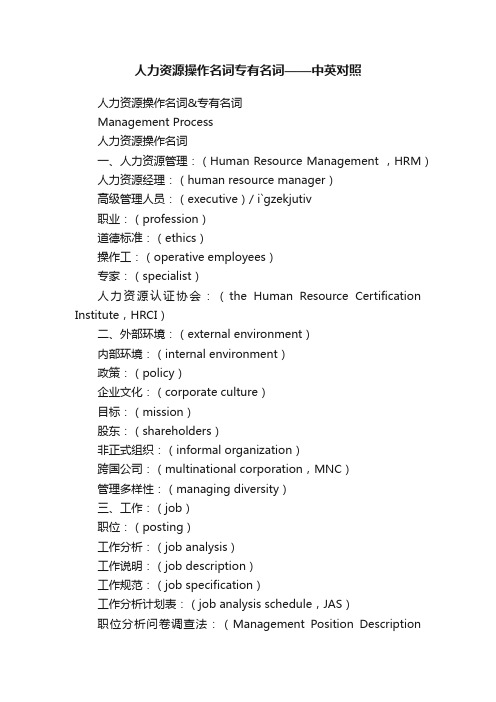
人力资源操作名词专有名词——中英对照人力资源操作名词&专有名词Management Process人力资源操作名词一、人力资源管理:(Human Resource Management ,HRM)人力资源经理:(human resource manager)高级管理人员:(executive)/ i`gzekjutiv职业:(profession)道德标准:(ethics)操作工:(operative employees)专家:(specialist)人力资源认证协会:(the Human Resource Certification Institute,HRCI)二、外部环境:(external environment)内部环境:(internal environment)政策:(policy)企业文化:(corporate culture)目标:(mission)股东:(shareholders)非正式组织:(informal organization)跨国公司:(multinational corporation,MNC)管理多样性:(managing diversity)三、工作:(job)职位:(posting)工作分析:(job analysis)工作说明:(job description)工作规范:(job specification)工作分析计划表:(job analysis schedule,JAS)职位分析问卷调查法:(Management Position DescriptionQuestionnaire,MPDQ)行政秘书:(executive secretary)地区服务经理助理:(assistant district service manager)四、人力资源计划:(Human Resource Planning,HRP)战略规划:(strategic planning)长期趋势:(long term trend)要求预测:(requirement forecast)供给预测:(availability forecast)管理人力储备:(management inventory)裁减:(downsizing)人力资源信息系统:(Human Resource Information System,HRIS)五、招聘:(recruitment)员工申请表:(employee requisition)招聘方法:(recruitment methods)内部提升:(Promotion From Within ,PFW)工作公告:(job posting)广告:(advertising)职业介绍所:(employment agency)特殊事件:(special events)实习:(internship)六、选择:(selection)选择率:(selection rate)简历:(resume)标准化:(standardization)有效性:(validity)客观性:(objectivity)规范:(norm)录用分数线:(cutoff score)准确度:(aiming)业务知识测试:(job knowledge tests)求职面试:(employment interview)非结构化面试:(unstructured interview)结构化面试:(structured interview)小组面试:(group interview)职业兴趣测试:(vocational interest tests)会议型面试:(board interview)七、组织变化与人力资源开发人力资源开发:(Human Resource Development,HRD)培训:(training)开发:(development)定位:(orientation)训练:(coaching)辅导:(mentoring)经营管理策略:(business games)案例研究:(case study)会议方法:(conference method)角色扮演:(role playing)工作轮换:(job rotating)在职培训:(on-the-job training ,OJT)媒介:(media)八、企业文化与组织发展企业文化:(corporate culture)组织发展:(organization development,OD)调查反馈:(survey feedback)质量圈:(quality circles)目标管理:(management by objective,MBO)全面质量管理:(T otal Quality Management,TQM)团队建设:(team building)九、职业计划与发展职业:(career)职业计划:(career planning)职业道路:(career path)职业发展:(career development)自我评价:(self-assessment)职业动机:(career anchors)十、绩效评价绩效评价:(Performance Appraisal,PA)小组评价:(group appraisal)业绩评定表:(rating scales method)关键事件法:(critical incident method)排列法:(ranking method)平行比较法:(paired comparison)硬性分布法:(forced distribution method)晕圈错误:(halo error)宽松:(leniency)严格:(strictness)3600反馈:(360-degree feedback)叙述法:(essay method)集中趋势:(central tendency)十一、报酬与福利报酬:(compensation)直接经济报酬:(direct financial compensation)间接经济报酬:(indirect financial compensation)非经济报酬:(no financial compensation)公平:(equity)外部公平:(external equity)内部公平:(internal equity)员工公平:(employee equity)小组公平:(team equity)工资水平领先者:(pay leaders)现行工资率:(going rate)工资水平居后者:(pay followers)劳动力市场:(labor market)工作评价:(job evaluation)排列法:(ranking method)分类法:(classification method)因素比较法:(factor comparison method)评分法:(point method)海氏指示图表个人能力分析法:(Hay Guide Chart-profile Method)工作定价:(job pricing)工资等级:(pay grade)工资曲线:(wage curve)工资幅度:(pay range)十二、福利和其它报酬问题福利(间接经济补偿)员工股权计划:(employee stock ownership plan,ESOP)值班津贴:(shift differential)奖金:(incentive compensation)分红制:(profit sharing)十三、安全与健康的工作环境安全:(safety)健康:(health)频率:(frequency rate)紧张:(stress)角色冲突:(role conflict)催眠法:(hypnosis)酗酒:(alcoholism)十四、员工和劳动关系工会:(union)地方工会:(local union)行业工会:(craft union)产业工会:(industrial union)全国工会:(national union)谈判组:(bargaining union)劳资谈判:(collective bargaining)仲裁:(arbitration)罢工:(strike)内部员工关系:(internal employee relations)纪律:(discipline)纪律处分:(disciplinary action)申诉:(grievance)降职:(demotion)调动:(transfer)晋升:(promotion)人力资源专有名词Action learning:行动学习Alternation ranking method:交替排序法Annual bonus:年终分红Application forms:工作申请表Appraisal interview:评价面试Aptitudes:资质Arbitration:仲裁Attendance incentive plan:参与式激励计划Authority:职权Behavior modeling:行为模拟Behaviorally anchored rating scale (bars):行为锚定等级评价法Benchmark job:基准职位Benefits:福利Bias:个人偏见Boycott:联合抵制Bumping/layoff procedures:工作替换/临时解雇程序Burnout:耗竭Candidate-order error:候选人次序错误Capital accumulation program:资本积累方案Career anchors:职业锚Career cycle:职业周期Career planning and development:职业规划与职业发展Case study method:案例研究方法Central tendency:居中趋势Citations:传讯Civil Rights Act:民权法Classes:类Classification (or grading)method:归类(或分级)法Collective bargaining:集体谈判Comparable worth:可比价值Compensable factor:报酬因素Computerized forecast:计算机化预测Content validity:内容效度Criterion validity:效标效度Critical incident method:关键事件法Davis-Bacon Act (DBA):戴维斯―佩根法案Day-to-day-collective bargaining:日常集体谈判Decline stage:下降阶段Deferred profit-sharing plan:延期利润分享计划Defined benefit:固定福利Defined contribution:固定缴款Department of Labor job analysis:劳工部工作分析法Discipline:纪律Dismissal:解雇;开除Downsizing:精简Early retirement window:提前退休窗口Economic strike:经济罢工Edgar Schein:艾德加·施恩Employee compensation:职员报酬Employee orientation:雇员上岗引导Employee Retirement Income Security Act (ERISA):雇员退休收入保障法案Employee services benefits:雇员服务福Employee stock ownership plan (ESOP):雇员持股计划Equal Pay Act:公平工资法Establishment stage:确立阶段Exit interviews:离职面谈Expatriate 外派雇员Expectancy chart:期望图表Expectancy Theory 期望理论Expectation 期望值Expected Salary 期望薪水Experimental Method 实验法Experimental Research 试验调查Experimentation:实验Expert systems 专家系统Expiry of Employment 雇用期满Exploit of HR 人力资源开发Exploration stage:探索阶段exterior communication divisionexterior communication division 外联处exterior documents 外来文件External analysis 外部分析External Costs 外部成本External Employment 外部招聘external environment 外部环境external equity 外部公平External growth strategy 外边成长战略External labor market 外部劳动力市场External Labor Supply 外部劳力供应External Recruiting Sources 外部招聘来源External Recruitment Environment 外部招聘环境Extra Work 加班Extrinsic Rewards 外部奖励Face Validity 表面效度facility division 设备处Fact-finder:调查factor comparison method 因素比较法Fair day's work:公平日工作Fair Labor Standards Act 公平劳动标准法案Fair Labor Standards Act:公平劳动标准法案Family and Medical Leave Act 家庭和医疗假期条例Family Leave 探亲假feedback 反馈field of production 生产现场field standard 现场标准finalize the design 定型financial department 财务部financial deputy president 财务副总裁finished goods 产成品First Impression Effect 初次印象效应Five-Day Workweek 每周五天工作制Fixed Term Appointment 固定期聘用Fixed Term Contract 固定任期合同Fixed Term Staff 固定期合同工FJA 功能性工作分析法FJA 职能工作分析Flat Organizational Structure 扁平化组织结构Flex Place 弹性工作地点Flex place:弹性工作地点Flex Plan 弹性工作计划flex time 弹性工作时间Flexible benefits plans 灵活的福利计划Flexible Benefits Program 弹性福利计划Flexible benefits programs:弹性福利计划Flextime 灵活的时间Flextime:弹性工作时间forced distribution method 硬性分布法Forced Distribution Method 强制分配法Forced distribution method:强制分布法Forced-Choice Method 强迫性选择法Forecasting 预测Formal education programs 正规教育计划Formal Organization 正式组织Four-day workweek:每周4天工作制Frame of reference 参照系Frederick Taylor:弗雷德里克·泰罗frequency rate 频率Front-Line Manager 基层管理人员fulfilling formalities 办理手续Full-Time 全职Function 职能Function of HRM 人力资源管理职能Functional Conflict Theory 冲突功能理论Functional control:职能控制Functional Department 职能部门Functional Job Analysis 功能性工作分析法Functional job analysis,FJA 职能工作分析Functional job analysis:功能性工作分析法Fundamental Attribution Error 基本归因误差Funeral Leave 丧假Gain sharing plans 收益分享计划Gang Boss 领班Gang Boss 小组长GA TB 普通能力倾向成套测验General Aptitude T est Battery 普通能力倾向成套测验General economic conditions:一般经济状况General Union 总工会Given Role Playing 角色定位演示法Glass Ceiling 玻璃天花板Globalization 全球化Goal Conflict 目标冲突Goals 目标Goals and timetables 目标和时间表going rate 现行工资率GOJA 指导性工作分析Golden Handshake 黄金握别Golden offerings:高龄给付Golden Parachute 黄金降落伞Good faith bargaining:真诚的谈判goods demand plan 要货计划government agents 政府人员Grade description:等级说明书Grades:等级grading method 分级法Graphic Design Division 平面设计处Graphic Rating Scale 图尺度评价法Graphic rating scale:图尺度评价法Graphic rating-scale method 图式评估法Grid training:方格训练Grievance Mediation 抱怨调解Grievance Procedure 抱怨程序Grievance procedure:抱怨程序grievance 申诉Gross Pay 工资总额group appraisal 小组评价Group Bonus 团体奖金Group Cohesiveness 群体凝集力Group Congeniality 群体凝集力Group Incentive Plan 团队激励计划group interview 小组面试Group Life Insurance 团体人寿保险Group life insurance:团体人寿保险Group pension plan:团体退休金计划Group mentoring program 群体指导计划Group Pension Plan 团体退休金计划Group Piece Work 集体计件制Group-building methods 团队建设法Growth stage:成长阶段Guarantee corporation:担保公司Guaranteed Employment Offer 雇用信Guaranteed fair treatment:有保证的公平对待Guaranteed piecework plan:有保障的计件工资制Gain sharing:收益分享guidelines and policies 方针政策Guidelines Oriented Job Analysis 指导性工作分析Handwriting Analysis 笔迹分析法Headhunting 猎头health 健康Health Insurance 健康保险Health Maintenance Organization 健康维护组织Health maintenance organization (HMO):健康维持组织Hierarchy of Needs Theory 需要层次理论High Performance Organization 高绩效组织High-leverage training 高层次培训High-Performance Work System 高绩效工作系统HMO 健康维护组织Holiday Pay 假日薪水holiday rotation 节假日轮流值班Home Leave 探亲假Horizontal Career Path 横向职业途径Hourly work 计时工资制Housing Allowance 住房补贴housing fund 住房公积金HR Generalist 人力资源通才HR Information System 人力资源信息系统HR Manager 人力资源经理HR Officer 人力资源主任HR Policy 人力资源政策HRCI 人力资源认证协会HRD 人力资源开发HRD Appraisal 人力资源开发评价HRD Intermediary 人力资源开发媒介HRD Process 人力资源开发过程HRIS 人力资源信息系统HRM 人力资源管理HRP 人力资源计划Human capital 人力资本Human Relations Movement 人际关系运动Human Resource Certification Institute 人力资源认证机构Human Resource Development 人力资源开发Human Resource Information System 人力资源信息系统human resource manager 人力资源经理Human Resource Planning 人力资源计划human resources department 人力资源部Hygiene Factor 保健因素Hypnosis 催眠Illegal bargaining:非法谈判项目Ill-Health Retirement 病退Impasse:僵持Implied authority:隐含职权implement of the training 培训实施incentive compensation 奖金Incentive Plan 激励计划Incentive plan:激励计划incentive system 奖金制Incentive-Suggestion System 奖励建议制度Incident Process 事件处理法income tax 所得税Independent Contractor 合同工Indirect costs 间接成本indirect financial compensation 间接经济报酬Individual Incentive Plan 个人奖金方案Individual Income Tax 个人所得税Individual Interview 个别谈话Individual Retirement Account 个人退休账户Individual retirement account (IRA):个人退休账户Individualism 个人主义Industrial Injury Compensation 工伤补偿industrial union 产业工会Informal Communication 非正式沟通informal organization 非正式组织informal organization 非正式组织information of new products 新品信息information of ordering goods 订货信息information of the market environment 市场环境信息information release 信息发布In-house development center:企业内部开发中心In-House Training 在公司内的培训Initial Interview 初试Instructional design process 指导性设计过程Insubordination:不服从Insurance Benefit 保险福利Insurance benefits:保险福利interior documents 内部文件Internal analysis 内部分析internal employee relations 内部员工关系internal environment 内部环境Internal Environment of HR 人力资源内部环境internal equity 内部公平Internal growth strategy 内部成长战略Internal Job Posting 内部职位公开招聘Internal labor force 内部劳动力Internal Recruitment 内部招聘Internal Recruitment Environment 内部招聘环境Internship programs 实习计划Interpersonal Skill 人际交往能力Interview Appraisal 面谈考评Interview Content 面试内容Interview Method 访谈法Interview Objective 面试目标Interview Planning List 面试计划表Interviews:谈话;面谈Intraorganizational bargaining 组织内谈判Intrinsic Reward 内在奖励investigation of workers’educational level 员工素质调查JAP 工作分析程序法JAS 工作分析计划表Job Account 工作统计Job Action 变相罢工Job Aid 工作辅助Job Analysis Formula 工作分析公式Job Analysis Information 工作分析信息Job Analysis Methods 工作分析方法Job Analysis Process 工作分析流程Job Analysis Program 工作分析程序法Job analysis:工作分析Job Assignment 工作分配Job Attitude 工作态度Job Bidding 竞争上岗Job Card 工作单Job Characteristic 工作因素Job Characteristics Model 工作特性模式Job Classification 职位分类Job classification system 工作分类法Job Clinic 职业问题咨询所Job Code 工作编号/职位编号Job Context 工作背景Job description 工作描述job description 工作说明job description 工作说明Job Description 职位描述Job description:工作描述Job design 工作设计Job enlargement 工作扩大化Job enrichment 工作丰富化job evaluation 工作评价Job evaluation:职位评价Job experiences 工作经验Job Identification 工作识别Job instruction training (JIT):工作指导培训Job Inventory 工作测量表Job involvement 工作认同Job Involvement 工作投入Job Knowledge Test 业务知识测试job knowledge tests 业务知识测试job knowledge tests 业务知识测试Job Morale 工作情绪Job Performance 工作表现Job Plan 工作计划job posting 工作公告job posting 工作公告Job Posting 公开招聘Job posting and bidding 工作张贴和申请Job posting:工作公告job pricing 工作定价Job progressions 工作提升Job Qualification and Restriction 工作任职条件和资格Job ranking system 工作重要性排序法Job Redesign 工作再设计Job rotation:工作轮换Job sharing:工作分组Job satisfaction 工作满意度Job Scope 工作范围Job Security 工作安全感Job Sharing 临时性工作分担Job Specialization 工作专业化job specification 工作规范Job Specification 工作要求细则Job specifications:工作说明书Job Standard 工作标准Job Stress 工作压力Job structure 工作结构Job Surrounding 工作环境Job Time Card 工作时间卡job transfer 转岗Job Vacancy 岗位空缺Job Vacancy 职业空缺Job-Family 工作群Job-hop 跳槽频繁者Job-posting system 工作告示系统Johari Window 约哈瑞窗户John Holland:约翰·霍兰德Junior Board 初级董事会Junior board:初级董事会Just Cause 正当理由Karoshi 过劳死Keogh Plan 基欧计划Key jobs 关键工作key Process Indication 企业关键业绩指标Kirkpatrick's Four-level Model of Evaluation 四阶层评估模型Knowledge Database 知识数据库Knowledge Management 知识管理KPI 企业关键业绩指标Labor Clause 劳工协议条款Labor Condition 劳动条件Labor Contract 劳动合同Labor Contract Renewal 劳动合同续签Labor Cost 劳动成本Labor Demand Forecast 劳动力需求预测Labor Discipline 劳动纪律Labor Dispute 劳动纠纷Labor Exchange 职业介绍所Labor Handbook 劳动手册Labor Hour 人工工时Labor Insurance 劳保Labor Laws 劳动法Labor Management Relations Act 劳动关系法Labor Management Relations Act 劳动关系法labor market 劳动力市场Labor Protection 劳动保护Labor Rate Variance 工资率差异Labor Redundance 劳动力过剩Labor Relation Consultant 劳工关系顾问Labor Relation 劳动关系Labor relations process 劳动关系进程Labor Relations Process 劳工关系进程Labor Reserve劳动力储备Labor Shortage劳动力短缺Labor Stability Index人力稳定指数Labor Union 工会Labor Wastage Index 人力耗损指数Layoff:临时解雇Leader attach training:领导者匹配训练Lifetime employment without guarantees:无保证终身解雇Line manager:直线管理者Local market conditions:地方劳动力市场Lockout:闭厂Maintenance stage:维持阶段Management assessment center:管理评价中心Management by objectives (MBO):目标管理法Management game:管理竞赛Management grid:管理方格训练Management process:管理过程Mandatory bargaining:强制谈判项目Mediation:调解Merit pay:绩效工资Merit raise:绩效加薪Mid career crisis sub stage:中期职业危机阶段Nondirective interview:非定向面试Occupational market conditions:职业市场状况Occupational orientation:职业性向Occupational Safety and Health Act:职业安全与健康法案Occupational Safety and Health Administration (OSHA):职业安全与健康管理局Occupational skills:职业技能On-the-job training (OJT):在职培训Open-door:敞开门户Opinion survey:意见调查Organization development(OD):组织发展Outplacement counseling:向外安置顾问Paired comparison method:配对比较法Panel interview:小组面试Participant diary/logs:现场工人日记/日志Pay grade:工资等级Pension benefits:退休金福利Pension plans:退休金计划People-first values:"以人为本"的价值观Performance analysis:工作绩效分析Performance Appraisal interview:工作绩效评价面谈Personnel (or human resource)management:人事(或人力资源)管理Personnel replacement charts:人事调配图Piecework:计件Plant Closing law:工厂关闭法Point method/Policies:政策Position Analysis Questionnaire (PAQ):职位分析问卷Position replacement cards:职位调配卡Pregnancy discrimination act:怀孕歧视法案Profit-sharing plan利润分享计划Programmed learning:程序化教学Qualifications inventories:资格数据库Quality circle:质量圈Ranking method:排序法Rate ranges:工资率系列Ratio analysis:比率分析Reality shock:现实冲击Reliability:信度Retirement benefits:退休福利Retirement counseling:退休前咨询Retirement:退休Rings of defense:保护圈Role playing:角色扮演Salary surveys:薪资调查Savings plan:储蓄计划Scallion plan:斯坎伦计划Scatter plot:散点分析Scientific management:科学管理Self directed teams:自我指导工作小组Self-actualization:自我实现Sensitivity training:敏感性训练Serialized interview:系列化面试Severance pay:离职金Sick leave:病假Situational interview:情境面试Skip-level interview:越级谈话Social security:社会保障Speak up! :讲出来!Special awards:特殊奖励Special management development techniques:特殊的管理开发技术Stabilization sub stage:稳定阶段Staff (service)function:职能(服务)功能Standard hour plan:标准工时工资Stock option:股票期权Straight piecework:直接计件制Strategic plan:战略规划Stress interview:压力面试Strictness/leniency:偏紧/偏松Strikes:罢工Structured interview:结构化面试Succession planning:接班计划Supplement pay benefits:补充报酬福利Supplemental unemployment benefits:补充失业福利Survey feedback:调查反馈Sympathy strike:同情罢工System Ⅳ组织体系ⅣSystem I:组织体系ⅠTask analysis:任务分析Team building:团队建设Team or group:班组Termination at will:随意终止Termination:解雇;终止Theory X:X理论Theory Y:Y理论Third-party involvement:第三方介入Training:培训Transactional analysis (TA):人际关系心理分析Trend analysis:趋势分析Trial sub stage:尝试阶段Unclear performance standards:绩效评价标准不清Unemployment insurance:失业保险Unfair labor practice strike:不正当劳工活动罢工Unsafe acts:不安全行为Unsafe conditions:不安全环境Validity:效度Value-based hiring:以价值观为基础的雇佣Variable compensation:可变报酬Vestibule or simulated training:新雇员培训或模拟Vesting:特别保护权V oluntary bargaining:自愿谈判项目V oluntary pay cut:自愿减少工资方案V oluntary time off:自愿减少时间Vroom-Yetton leadership trainman:维罗姆-耶顿领导能力训练Wage carve:工资曲线Work samples:工作样本Work sampling technique:工作样本技术Work sharing:临时性工作分担Worker involvement:雇员参与计划Worker's benefits:雇员福利。
人力资源管理英文名词解释

人力资源管理英文名词解释引言在当今全球化和竞争激烈的商业环境中,人力资源管理(Human Resource Management)起着至关重要的作用。
人力资源部门不仅需要招聘和雇佣员工,还需要管理员工的培训、绩效评估和福利等方面。
本文将详细解释一些常见的人力资源管理英文名词,帮助读者更好地理解和运用这些概念。
1. Recruitment(招聘)Recruitment是指组织在需要新员工时,通过各种渠道和方法来吸引、筛选和选择合适的候选人的过程。
这包括发布招聘广告、筛选简历、面试候选人等。
2. Selection(选择)Selection是在招聘过程中,通过评估和比较候选人的技能、经验、能力等因素来做出选择的过程。
这可以包括面试、测试、背景调查等。
3. Training and Development(培训与发展)Training and Development是指为提高员工的工作能力和职业发展,组织提供的各种培训和发展机会。
这可以包括内部培训、外部培训、工作轮岗等。
4. Performance Appraisal(绩效评估)Performance Appraisal是指对员工工作表现进行评估和记录的过程。
这可以通过定期的绩效评估、360度评估等方法来完成。
5. Compensation and Benefits(薪酬与福利)Compensation and Benefits是指组织向员工提供的金钱和非金钱回报。
这包括工资、奖金、福利、假期等。
6. Employee Engagement(员工参与度)Employee Engagement是指员工对组织的投入程度和参与程度。
这包括员工对工作的满意度、忠诚度和积极性等。
7. Employee Retention(员工留任)Employee Retention是指组织保留和留住员工的能力。
这可以通过提供有吸引力的福利和发展机会、合理的工作条件等来实现。
公司部门英文名称大全

公司部门英文名称大全总公司Head Office分公司Branch Office营业部Business Office人事部Personnel Department人力资源部Human Resources Department总务部General Affairs Department财务部General Accounting Department销售部Sales Department促销部Sales Promotion Department国际部International Department出口部Export Department进口部Import Department公共关系Public Relations Department广告部Advertising Department企划部Planning Department产品开发部Product Development Department研发部Research and Development Department(R&D) 秘书室Secretarial Pool采购部Purchasing Department工程部Engineering Department行政部Admin. Department人力资源部HR Department市场部Marketing Department技术部Technolog Department客服部Service Department行政部Administration财务部Financial Department总经理室Direcotor, or President副总经理室Deputy Director, or Vice president总经办General Deparment采购部Purchase & Order Department工程部Engineering Deparment研发部Research Deparment生产部Productive Department销售部Sales Deparment广东业务部GD Branch Deparment无线事业部Wireless Industry Department拓展部Business Expending Department物供部Supply DepartmentB&D business and development 业务拓展部Marketing 市场部Sales 销售部HR 人力资源部Account 会计部PR people relationship 公共关系部OFC (Office, 但不常见) / OMB = Office of Management and Budget 办公室Finance 财务部MKTG (Marketing) 市场部R&D (Research & Development) 研发部MFG (Manufacturing) 产品部Administration Dept. 管理部Purchasing Dept 采购部Chairman/President Office // Gerneral Manager office or GM office 总经理办公室Monitor & Support Department 监事会Strategy Research 战略研究部注:有时候同一个部门,在你们厂和我们公司它的叫法就是不一样;在美国和英国或新西兰它也不一样。
人力资源管理英文版选择题题库1
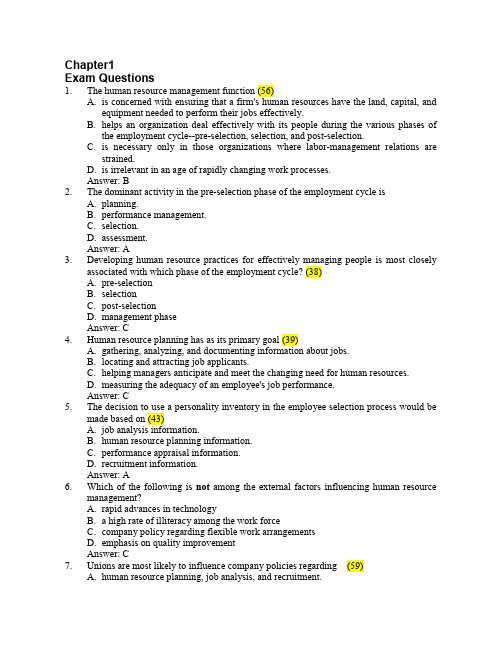
Chapter1Exam Questions1. The human resource management function (56)A. is concerned with ensuring that a firm's human resources have the land, capital, andequipment needed to perform their jobs effectively.B. helps an organization deal effectively with its people during the various phases ofthe employment cycle--pre-selection, selection, and post-selection.C. is necessary only in those organizations where labor-management relations arestrained.D. is irrelevant in an age of rapidly changing work processes.Answer: B2. The dominant activity in the pre-selection phase of the employment cycle isA. planning.B. performance management.C. selection.D. assessment.Answer: A3. Developing human resource practices for effectively managing people is most closelyassociated with which phase of the employment cycle? (38)A. pre-selectionB. selectionC. post-selectionD. management phaseAnswer: C4. Human resource planning has as its primary goal (39)A. gathering, analyzing, and documenting information about jobs.B. locating and attracting job applicants.C. helping managers anticipate and meet the changing need for human resources.D. measuring the adequacy of an employee's job performance.Answer: C5. The decision to use a personality inventory in the employee selection process would bemade based on (43)A. job analysis information.B. human resource planning information.C. performance appraisal information.D. recruitment information.Answer: A6. Which of the following is not among the external factors influencing human resourcemanagement?A. rapid advances in technologyB. a high rate of illiteracy among the work forceC. company policy regarding flexible work arrangementsD. emphasis on quality improvementAnswer: C7. Unions are most likely to influence company policies regarding (59)A. human resource planning, job analysis, and recruitment.B. discipline, promotions, and grievances.C. international human resource management.D. strategic planning and resource allocation.Answer: B8. Which of the following is not one of the issues that needs to be addressed whenestablishing operations in other countries?A. setting performance standardsB. use of expatriatesC. cultural differencesD. compensationAnswer: A9. Which statement below best describes the relationship between line management andHR professionals? (58)A. HR professionals focus more on developing human resource programs, while linemanagers are more involved in implementing those programs.B. HR professionals are solely responsible for evaluating programs designed to managehuman resources.C. Line management requires the services of the HR professional only infrequently.D. Line management focuses more on developing human resource programs, while theHR professional is more involved in implementing programs.Answer: A10 Which of the following activities is most consistent with the HR professional’s role ofdeveloping/choosing HRM methods? (31)A. determining the order in which job applicants should complete selection measures.B. determining that a test of cognitive ability should be used as part of a selectionprocess.C. determining that a personality test has been ineffective in screening job applicants.D. offering a manager instruction on how to appraise employee performance.Answer: B11. Which of the following activities is not part of the line manager's role in the HRMprocess? (32)A. interview job applicantsB. settle grievance issuesC. provide and communicate job performance ratingsD. develop an evaluation strategy for training programsAnswer: D12. A competitive advantage is defined in the text as (33)A. a demonstrated willingness to take on all competitors in the marketplace.B. hiring a workforce that has a high need for achievement.C. achieving a superior marketplace position relative to one’s competition.D. organizational self-confidence.Answer: C13. A cost leadership strategy for gaining competitive advantage can be produced by(34)A. reducing the cost of production, regardless of the number of units produced.B. increasing the number of units produced, regardless of the cost per unit.C. cutting overhead costs while maintaining or increasing the number of unitsproduced.D. performing regularly scheduled maintenance on production equipment.Answer: C14. Product differentiation can offer a firm a competitive advantage because (35)A. it allows a firm to offer a unique product not being offered by competitors.B. it can reduce a product’s cost per unit.C. it reduces a firm’s dependence on one supplier for raw materials.D. imitating a competitor’s strategy is the surest way to be competitive.Answer: A15. Which of the following statements best characterizes the relationship between a firm’sHRM practices and important outcome measures such as productivity, profits, and overall organizational performance? (36)A. HRM practices have little impact on such“hard measures”of organizationalperformance.B. Firms with progressive HRM practices tend to perform better on such hard measuresof organizational performance than those using less sound practices.C. Those firms that use sophisticated HRM practices tend to be only slightly lesssuccessful than other firms.D. The more money a firms spends on salaries for HRM personnel, the more successfulit will be.Answer: B16. According to Jeffrey Pfeffer, a firm that adopts a program of employee participation andempowerment is most likely to generate (37)A. uncertainty among the workforce regarding job responsibilities.B. support from union leadership.C. a decline in short-term profits until the organization adapts to the change.D. a competitive advantage by increasing employee satisfaction and productivity.Answer: D17. According to the model linking HRM practices to competitive advantage discussed inchapter 1, which of the following HRM practices can have a direct effect on achieving competitive advantage?A. performance appraisalB. HR planningC. unionsD. workplace justice programsAnswer: A18. According to the model linking HRM practices to competitive advantage discussed inchapter 1, which of the following employee-centered outcomes is a direct result of implementing progressive HRM practices?A. employee retentionB. legal complianceC. employee competenceD. company imageAnswer: C19. Organizational citizenship concerns(40)A. an employee’s willingness to engage in work behaviors that are not usually specifiedin a job description.B. the relative strength of an employee’s identification with and involvement in aparticular organization.C. the favorableness of an employee’s attitude toward his or her job.D. the tendency of an organization to be involved in the civic affairs of the communityin which it resides.Answer: A20. An employee is overheard saying“I think the company is doing the right thing byintroducing this new product line. I hope I get the chance to work on it.” This statement most likely reflects the employee’s (41)A. organizational commitment.B. organizational citizenship.C. job satisfaction.D. self-efficacy.Answer: A21. Which of the following pairs of HRM practices is most likely to influence employeemotivation?(42)A. job analysis and HR planningB. selection and productivity improvement programsC. training and safety and health programsD. motivation is one of the few variables that cannot be improved using HR practices.Answer: B22. According to the model linking HRM practices to competitive advantage discussed inChapter 1, how can one describe the relationship between organization-centered outcomes and employee-centered outcomes?A. organization-centered outcomes are believed to“cause”employee-centeredoutcomes.B. employee-centered outcomes are believed to“cause”organization-centeredoutcomes.C. both employee-centered and organization-centered outcomes are believed to havedirect paths to competitive advantage but no effect on each other.D. organization-centered outcomes are directly influenced by certain HRM practices,while employee-centered outcomes are not.Answer: B23. Which of the following strategies is not used by HR professionals to achieve costleadership? (44)A. motivating workers to be more productive by introducing a productivityimprovement program.B. developing a performance appraisal system that provides workers with the feedbacknecessary to be more productive.C. introducing a new piece of equipment to improve worker efficiency.D. using a more efficient recruitment strategy to reduce the cost of hiring new workers.Answer: C24. The use of HRM practices can promote a sustained competitive advantage because(45)A. being the first to institute an innovative HR practice discourages a firm'scompetition.B. HR practices cannot be imitated.C. people are a firm’s most valuable resource.D. the organizational environment in which innovative HR practices are implementedcan rarely be duplicated.Answer: D25. Which of the following HR practices is likely to have the greatest and most directimpact on achieving competitive advantage through product differentiation?A. compensationB. selectionC. job analysisD. performance appraisalAnswer: B。
企业招聘的六大原则
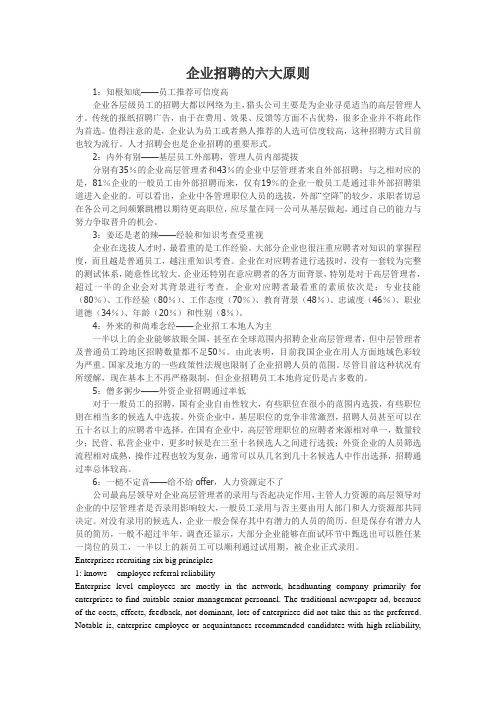
企业招聘的六大原则1:知根知底——员工推荐可信度高企业各层级员工的招聘大都以网络为主,猎头公司主要是为企业寻觅适当的高层管理人才。
传统的报纸招聘广告,由于在费用、效果、反馈等方面不占优势,很多企业并不将此作为首选。
值得注意的是,企业认为员工或者熟人推荐的人选可信度较高,这种招聘方式目前也较为流行。
人才招聘会也是企业招聘的重要形式。
2:内外有别——基层员工外部聘,管理人员内部提拔分别有35%的企业高层管理者和43%的企业中层管理者来自外部招聘;与之相对应的是,81%企业的一般员工由外部招聘而来,仅有19%的企业一般员工是通过非外部招聘渠道进入企业的。
可以看出,企业中各管理职位人员的选拔,外部“空降”的较少,求职者切忌在各公司之间频繁跳槽以期待更高职位,应尽量在同一公司从基层做起,通过自己的能力与努力争取晋升的机会。
3:姜还是老的辣——经验和知识考查受重视企业在选拔人才时,最看重的是工作经验。
大部分企业也很注重应聘者对知识的掌握程度,而且越是普通员工,越注重知识考查。
企业在对应聘者进行选拔时,没有一套较为完整的测试体系,随意性比较大。
企业还特别在意应聘者的各方面背景,特别是对于高层管理者,超过一半的企业会对其背景进行考查。
企业对应聘者最看重的素质依次是:专业技能(80%)、工作经验(80%)、工作态度(70%)、教育背景(48%)、忠诚度(46%)、职业道德(34%)、年龄(20%)和性别(8%)。
4:外来的和尚难念经——企业招工本地人为主一半以上的企业能够放眼全国,甚至在全球范围内招聘企业高层管理者,但中层管理者及普通员工跨地区招聘数量都不足50%。
由此表明,目前我国企业在用人方面地域色彩较为严重。
国家及地方的一些政策性法规也限制了企业招聘人员的范围。
尽管目前这种状况有所缓解,现在基本上不再严格限制,但企业招聘员工本地肯定仍是占多数的。
5:僧多粥少——外资企业招聘通过率低对于一般员工的招聘,国有企业自由性较大,有些职位在很小的范围内选拔,有些职位则在相当多的候选人中选拔。
HR专业术语(中英对照)
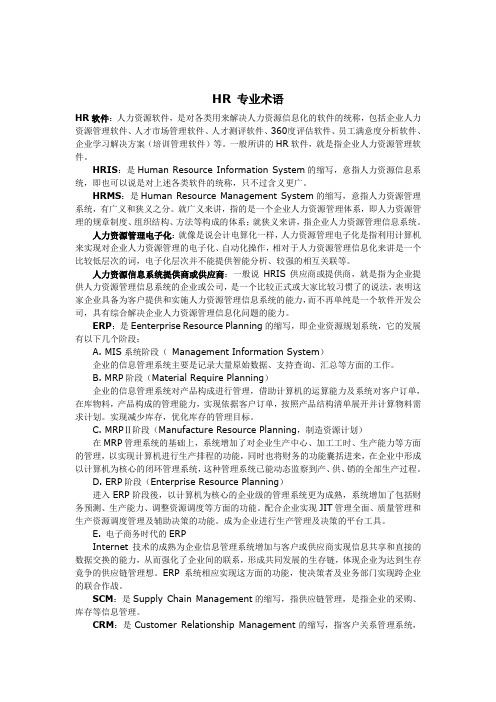
HR 专业术语HR软件:人力资源软件,是对各类用来解决人力资源信息化的软件的统称,包括企业人力资源管理软件、人才市场管理软件、人才测评软件、360度评估软件、员工满意度分析软件、企业学习解决方案(培训管理软件)等。
一般所讲的HR软件,就是指企业人力资源管理软件。
HRIS:是Human Resource Information System的缩写,意指人力资源信息系统,即也可以说是对上述各类软件的统称,只不过含义更广。
HRMS:是Human Resource Management System的缩写,意指人力资源管理系统,有广义和狭义之分。
就广义来讲,指的是一个企业人力资源管理体系,即人力资源管理的规章制度、组织结构、方法等构成的体系;就狭义来讲,指企业人力资源管理信息系统。
人力资源管理电子化:就像是说会计电算化一样,人力资源管理电子化是指利用计算机来实现对企业人力资源管理的电子化、自动化操作,相对于人力资源管理信息化来讲是一个比较低层次的词,电子化层次并不能提供智能分析、较强的相互关联等。
人力资源信息系统提供商或供应商:一般说HRIS供应商或提供商,就是指为企业提供人力资源管理信息系统的企业或公司,是一个比较正式或大家比较习惯了的说法,表明这家企业具备为客户提供和实施人力资源管理信息系统的能力,而不再单纯是一个软件开发公司,具有综合解决企业人力资源管理信息化问题的能力。
ERP:是Eenterprise Resource Planning的缩写,即企业资源规划系统,它的发展有以下几个阶段:A. MIS系统阶段(Management Information System)企业的信息管理系统主要是记录大量原始数据、支持查询、汇总等方面的工作。
B. MRP阶段(Material Require Planning)企业的信息管理系统对产品构成进行管理,借助计算机的运算能力及系统对客户订单,在库物料,产品构成的管理能力,实现依据客户订单,按照产品结构清单展开并计算物料需求计划。
公司关于开展年度员工评选工作的通知文档
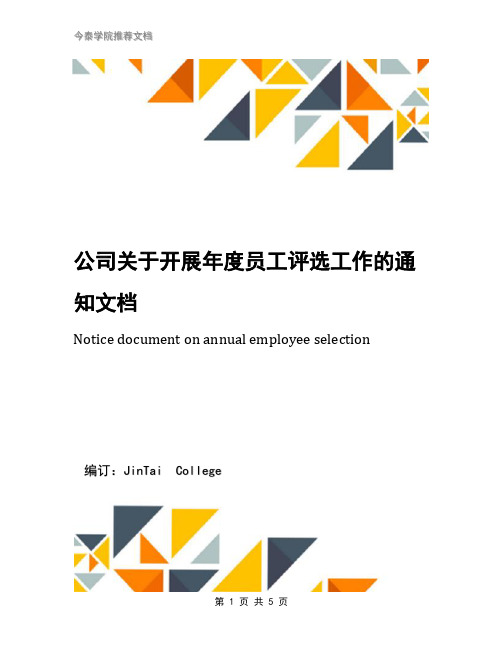
公司关于开展年度员工评选工作的通知文档Notice document on annual employee selection编订:JinTai College公司关于开展年度员工评选工作的通知文档前言:信函指以套封形式按照名址递送给特定个人或单位的缄封的信息载体。
本文档根据信函内容要求和特点展开说明,具有实践指导意义,便于学习和使用,本文下载后内容可随意调整修改及打印。
公司各单位:在即将过去的~年度里,公司生产经营和各项工作均取得了比较可喜的成效,公司涌现出了一大批兢兢业业、勤勤恳恳、尽职尽责的优秀员工。
为表彰在~年度中做出显著成绩的优秀者,同时以优秀员工的事迹推动公司全员在~年的各项工作中再创佳绩,进一步增强员工的整体战斗力和凝聚力,促进企业健康、快速发展,全面提升企业的运行质态和管理水平,公司决定在全公司范围内开展~年度优秀员工评选工作。
现将评选工作的有关事项通知如下:一.荣誉称号:1.综合荣誉:优秀员工2.单项荣誉:质量标兵、生产标兵、文明标兵二.评选范围:优秀员工、文明标兵评选范围为公司全体员工(除公司领导外),质量标兵、生产标兵等单项荣誉评选范围为公司生产一线操作工。
入厂不足6个月的员工不在荣誉评选范围。
三.评选比例:为平衡各部门工作,原则上按附表指标推荐评眩车间、部门主要负责人由有关部门和公司领导直接评眩四.评选条件:1.优秀员工:品德素养、业务素质、技能水平优良,爱岗敬业,诚信务实,在本岗位上发挥重要作用,出色完成本职工作,受本部门人员一致赞扬;有团队合作精神,与同事工作主动沟通配合;完全服从并能按要求完成工作安排,模范执行企业各项管理制度、规程,全年没有受过重大处罚;在生产、质量、管理、安全、环保、节能降耗等方面主动提出合理化建议,为公司创造良好效益或在其它方面做出了突出贡献。
2.质量标兵:具有较强的产品质量意识和过硬的技能水平,严格执行工艺纪律,在生产过程中积极主动地加强质量控制,为完成本车间质量指标起表率作用;能为提高产品质量积极提出合理化建议或进行技术革新并取得成效;本年度未发生b类工艺违纪和a类质量问题,未受过质量问题方面重大处罚。
人力考卷答案完整版

课堂练习(复习)一、名词解释 (英文答题,每小题4分,共20分)二、单项选择题(从下列各题四个备选答案中选出一个正确答案,并将其代号写在答题纸相应位置处。
每小题1.5分,共15分)三、判断题(判断以下命题的正误,认为正确的就在答题相应位置划“T”,错误的划“F”。
每小题1.5分,共15分)四、简答题(此题允许用中文答题。
每小题10分,共30分)五、案例分析题(此题允许用中文答题。
共20分)一、名词解释1. Human resource managementIs a set of interrelated policies, practices and programs whose goal is to attract, socialize, motivate ,maintain, and organization’s employees.2. Line authorityThe authority of managers to direct people in his or her own department.3. Job analysisis the procedure through which you determine the duties and nature of the jobs and the kinds of people who should be hired for them.4. Job descriptionA list of a job's duties, responsibilities, reporting relationships, working conditions, and supervisory responsibilities--one product of a job analysis.5. Job specificationA list of a job's "human requirements," that is, the requisite education, skills, personality, and so on--another product of a job analysis.6. Human Resource planningGetting the right people at right place at the right time.The process of deciding what positions the firm will have to fill, and how to fill them.An HRM practice that helps managers anticipate and meet changing needs relating to the acquisition, deployment, and utilization of employees 人力资源规划:一个帮助公司鉴别它们未来的人力资源管理需求以及如何满足这些需求的过程7. Reliabilityrefers to the consistency of the testThe characteristic which refers to the consistency of scores obtained by the same person when retested with the identical or equivalent tests.8. Negligent hiringHiring workers with criminal backgrounds without proper safeguards.9. Employee orientation定向培训:A procedure for providing new employees with basic background information about the firm.10. Forced distribution methodIs similar to grading on a curve. With this method, you place pred etermined percentages of the rated employees into performance categories.类似于在一条曲线上区分等级,被评价员工按照预定的比例被置于不同的绩效等级。
人力资源类词语
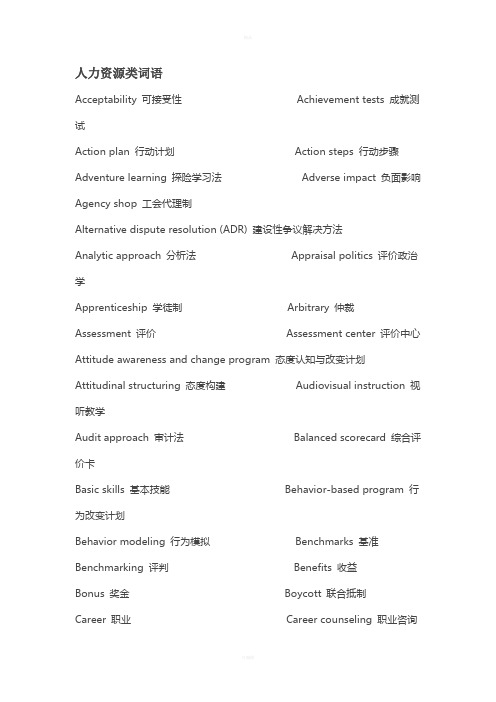
人力资源类词语Acceptability 可接受性Achievement tests 成就测试Action plan 行动计划Action steps 行动步骤Adventure learning 探险学习法Adverse impact 负面影响Agency shop 工会代理制Alternative dispute resolution (ADR) 建设性争议解决方法Analytic approach 分析法Appraisal politics 评价政治学Apprenticeship 学徒制Arbitrary 仲裁Assessment 评价Assessment center 评价中心Attitude awareness and change program 态度认知与改变计划Attitudinal structuring 态度构建Audiovisual instruction 视听教学Audit approach 审计法Balanced scorecard 综合评价卡Basic skills 基本技能Behavior-based program 行为改变计划Behavior modeling 行为模拟Benchmarks 基准Benchmarking 评判Benefits 收益Bonus 奖金Boycott 联合抵制Career 职业Career counseling 职业咨询Career curves (maturity curves) 职业曲线(成熟曲线)Career management system 职业管理系统Career support 职业支持Centralization 集权化Coach 教练Cognitive ability 认知能力Cognitive outcomes 认知性结果Collective bargaining process 劳资谈判过程Community of practice 演练小组Compa-ratio 比较比率Compensable factors 报酬要素Competency assessment 能力评估Competitive advantage 竞争优势Concentration strategy 集中战略Concurrent validation 同时效度Consumer price index, CPI 消费者价格指数Content validation 内容效度Continuous learning 持续学习Contributory plan 投入计划Coordination training 合作培训Core competencies 核心竞争力Criterion-related validity 效标关联效度Critical incident 关键事件Critical incident method 关键事件法Cross-cultural preparation 跨文化准备Cross-training 交叉培训Cultural environment 文化环境Cultural shock 文化冲击Customer appraisal 顾客评估Data flow diagram 数据流程图Database 数据库Decentralization 分散化Decision support systems 决策支持系统Defined-benefit plan 养老金福利计划Defined-contribution plan 资方养老金投入计划Delayering 扁平化Depression 沮丧Development planning system 开发规划系统Differential piece rate 差额计件工资Direct costs 直接成本Discipline 纪律Disparate impact 差别性影响Disparate treatment 差别性对待Diversity training 多元化培训Downsizing 精简Downward move 降级Efficiency wage theory 效率工资理论Electronic performance support system (EPSS) 电子绩效支持系统Employee empowerment 员工授权Employee leasing 员工租借Employee survey research 雇员调查与研究Employee wellness programs (EWPs) 雇员健康修炼计划Entrepreneur 企业家Equal employment opportunity(EEO) 公平就业机会Essay method 书面方式Ethics 道德Expatriate 外派雇员Expert systems 专家系统External analysis 外部分析External growth strategy 外边成长战略External labor market 外部劳动力市场Factor comparison system 因素比较法Feedback 反馈Flexible benefits plans (cafeteria plans) 灵活的福利计划(自助福利方案)Flextime 灵活的时间Forecasting(劳动力供求)预测Formal education programs 正规教育计划Frame of reference 参照系Functional job analysis, FJA 职能工作分析Gain sharing plans 收益分享计划Globalization 全球化Goals 目标Goals and timetables 目标和时间表Graphic rating-scale method 图式评估法Group-building methods 团队建设法Group mentoring program 群体指导计划Hay profile method 海氏剖析法High-leverage training 高层次培训High-performance work systems 高绩效工作系统Hourly work 计时工资制Human capital 人力资本Human resource information system (HRIS) 人力资源信息系统Human resource management 人力资源管理Human resources planning, HRP 人力资源计划Indirect costs 间接成本Individualism/collectivism 个人主义/集体主义Input 投入Instructional design process 指导性设计过程Internal analysis 内部分析Internal growth strategy 内部成长战略Internal labor force 内部劳动力Internet 互联网Internship programs 实习计划Interview 面试Intraorganizational bargaining 组织内谈判Job analysis 工作分析Job classification system 工作分类法Job description 工作描述Jobdesign 工作设计Job enlargement 工作扩大化Job enrichment 工作丰富化Job evaluation 工作评价Job experiences 工作经验Job involvement 工作认同Job posting and bidding 工作张贴和申请Job progressions 工作提升Job ranking system 工作重要性排序法Job rotation 工作轮换Job satisfaction 工作满意度Job specification 工作规范Job structure 工作结构Key jobs 关键工作Labor market 劳动力市场Labor relations process 劳动关系进程Leaderless group discussion 无领导小组讨论法Learning organization 学习型组织Long-term-short-term orientation 长期-短期导向Maintenance of membership 会员资格维持Management by objectives, MBO 目标管理Management forecasts 管理预测Management prerogatives 管理特权Manager and / or supervisor appraisal 经理和/或上司评估Managing diversity 管理多元化Markov analysis 马克夫分析法Mediation 调解Mentor 导师Merit guideline 绩效指南Minimum wage 最低工资Motivation to learn 学习的动机Needs assessment(培训)需要评价Negligence 疏忽Nepotism 裙带关系Ombudsman 调查专员On-the-job training, OJT 在职培训Opportunity to perform 实践的机会Organizational analysis 组织分析Organizational capability 组织能力Orientation 导向培训Outplacement counseling 重新谋职咨询Output 产出Outsourcing 外包Panel interview 小组面试Pay-for-performance standard 按绩效的报酬标准Pay grade 工资等级Pay level 工资水平Pay-policy line 工资政策线Pay structure 工资结构Peer appraisal 同事评估Performance appraisal 绩效评价Performance feedback 绩效反馈Performance management 绩效管理Performance planning and evaluation (PPE) 绩效规划与评价系统Perquisites 津贴Person analysis 个人分析Person characteristics 个人特征Personnel selection 人员甄选Point system 积分法Position analysis questionnaire, PAQ 职位分析问卷调查Power distance 权力差距Predictive validation 预测效度Profit sharing 利润分享Promotion 晋升Protean career多变的职业Psychological contract 心理契约Psychological support 心理支持Range spread 工资范围跨度Readability 易读性Readiness for training 培训准备Reasoning ability推理能力Recruitment 招募Reengineering 流程再造Relational database 关联数据库Reliability 信度Repatriation 归国准备Replacement charts 替换表Request for proposal (REP)(培训)招标书Return on investment (ROI) 投资回报Role ambiguity 角色模糊Role analysis technique 角色分析技术Role play 角色扮演School-to-work 从学校到工作Selection 甄选Self-appraisal 自我评估Situational interview 情景面试Skill-based pay 技能工资Skill inventories 技能量表Specificity 明确性Spot bonus 即时奖金Staffing tables 人员配置表Strategic choice 战略选择Strategic congruence 战略一致性Strategic human resource management (SHRM) 战略性人力资源管理Strategy formulation 战略形成Strategy implementation 战略执行Task analysis 任务分析Team leader training 团队领导培训360-degree feedback process 360度反馈过程Total quality management (TQM) 全面质量管理Training 培训Training administration 培训管理Training outcomes 培训结果Transaction processing 事务处理Trend analysis 趋势分析Utility 效用Utility analysis 效用分析Validity 效度Verbal comprehension 语言理解能力Vesting 既得利益Voicing 发言Wage and salary survey 薪资调查Wage-rate compression 工资压缩Web-based training 网上培训Work permit/ work certificate 就业许可证Yield ratio 成功率人力资源管理:(Human Resource Management ,HRM)人力资源经理:( human resource manager) 高级管理人员:(executive) 职业:(profession) 道德标准:(ethics)操作工:(operative employees) 专家:(specialist)人力资源认证协会:(the Human Resource Certification Institute,HRCI).外部环境:(external environment) 内部环境:(internal environment)政策:(policy) 企业文化:(corporate culture) 目标:(mission) 股东:(shareholders)非正式组织:(informal organization) 跨国公司:(multinational corporation,MNC)管理多样性:(managing diversity).工作:(job) 职位:(posting)工作分析:(job analysis) 工作说明:(job description)工作规范:(job specification) 工作分析计划表:(job analysis schedule,JAS)职位分析问卷调查法:(Management Position Description Questionnaire,MPDQ)行政秘书:(executive secretary)地区服务经理助理:(assistant district service manager).人力资源计划:(Human Resource Planning,HRP) 战略规划:(strategic planning)长期趋势:(long term trend) 要求预测:(requirement forecast)供给预测:(availability forecast) 管理人力储备:(management inventory)裁减:(downsizing) 人力资源信息系统:(Human Resource Information System,HRIS).招聘:(recruitment) 员工申请表:(employee requisition)招聘方法:(recruitment methods) 内部提升:(Promotion From Within ,PFW)工作公告:(job posting) 广告:(advertising)职业介绍所:(employment agency) 特殊事件:(special events)实习:(internship).选择:(selection) 选择率:(selection rate)简历:(resume) 标准化:(standardization)有效性:(validity) 客观性:(objectivity)规范:(norm) 录用分数线:(cutoff score)准确度:(aiming) 业务知识测试:(job knowledge tests)求职面试:(employment interview) 非结构化面试:(unstructuredinterview)结构化面试:(structured interview) 小组面试:(group interview)职业兴趣测试:(vocational interest tests) 会议型面试:(board interview) .组织变化与人力资源开发人力资源开发:(Human Resource Development,HRD)培训:(training) 开发:(development)定位:(orientation) 训练:(coaching)辅导:(mentoring) 经营管理策略:(business games)案例研究:(case study) 会议方法:(conference method)角色扮演:(role playing) 工作轮换:(job rotating)在职培训:(on-the-job training ,OJT) 媒介:(media).企业文化与组织发展企业文化:(corporate culture) 组织发展:(organization development,OD)调查反馈:(survey feedback) 质量圈:(quality circles)目标管理:(management by objective,MBO)全面质量管理:(Total Quality Management,TQM)团队建设:(team building).职业计划与发展职业:(career) 职业计划:(career planning)职业道路:(career path) 职业发展:(career development)自我评价:(self-assessment) 职业动机:(career anchors).绩效评价绩效评价:(Performance Appraisal,PA) 小组评价:(group appraisal) 业绩评定表:(rating scales method) 关键事件法:(critical incident method)排列法:(ranking method) 平行比较法:(paired comparison)硬性分布法:(forced distribution method) 晕圈错误:(halo error)宽松:(leniency) 严格:(strictness)反馈:(-degree feedback) 叙述法:(essay method)集中趋势:(central tendency).报酬与福利报酬:(compensation) 直接经济报酬:(direct financial compensation) 间接经济报酬:(indirect financial compensation)非经济报酬:(no financial compensation) 公平:(equity)外部公平:(external equity) 内部公平:(internal equity)员工公平:(employee equity) 小组公平:(teamequity)工资水平领先者:(pay leaders) 现行工资率:(going rate)工资水平居后者:(pay followers) 劳动力市场:(labor market)工作评价:(job evaluation) 排列法:(ranking method)分类法:(classification method) 因素比较法:(factor comparison method)评分法:(point method)海氏指示图表个人能力分析法:(Hay Guide Chart-profile Method)工作定价:(job pricing) 工资等级:(pay grade)工资曲线:(wage curve) 工资幅度:(pay range).福利和其它报酬问题福利(间接经济补偿) 员工股权计划:(employee stock ownership plan,ESOP)值班津贴:(shift differential) 奖金:(incentive compensation)分红制:(profit sharing).安全与健康的工作环境安全:(safety) 健康:(health)频率:(frequency rate) 紧张:(stress)角色冲突:(role conflict) 催眠法:(hypnosis)酗酒:(alcoholism).员工和劳动关系工会:(union) 地方工会:(local union)行业工会:(craft union) 产业工会:(industrial union)全国工会:(national union) 谈判组:(bargaining union)劳资谈判:(collective bargaining) 仲裁:(arbitration)罢工:(strike) 内部员工关系:(internal employee relations)纪律:(discipline) 纪律处分:(disciplinary action)申诉:(grievance) 降职:(demotion)调动:(transfer) 晋升:(promotion)。
HR相关英文词汇

HR相关英文词汇1.人力资源管理:Human Resource Management ,HRM人力资源经理: human resource manager高级管理人员:executive职业:profession道德标准:ethics操作工:operative employees专家:specialist人力资源认证协会:the Human Resource Certification Institute,HRCI 2.外部环境:external environment内部环境:internal environment政策:policy企业文化:corporate culture目标:mission股东:shareholders非正式组织:informal organization跨国公司:multinational corporation,MNC管理多样性:managing diversity3.工作:job职位:posting工作分析:job analysis工作说明:job de script ion工作规范:job specification工作分析计划表:job analysis schedule, JAS职位分析问卷调查法:Management Position De script ion Questionnaire, MPDQ 行政秘书:executive secretary地区服务经理助理:assistant district service manager4.人力资源计划:Human Resource Planning, HRP战略规划:strategic planning长期趋势:long term trend要求预测:requirement forecast供给预测:availability forecast管理人力储备:management inventory裁减:downsizing人力资源信息系统:Human Resource Information System, HRIS 5.招聘:recruitment员工申请表:employee requisition招聘方法:recruitment methods内部提升:Promotion From Within ,PFW工作公告:job posting广告:advertising职业介绍所:employment agency特殊事件:special events实习:internship6.选择:selection选择率:selection rate简历:resume标准化:standardization有效性:validity客观性:objectivity规范:norm录用分数线:cutoff score准确度:aiming业务知识测试:job knowledge tests求职面试:employment interview非结构化面试:unstructured interview结构化面试:structured interview小组面试:group interview职业兴趣测试:vocational interest tests会议型面试:board interview7.组织变化与人力资源开发人力资源开发:Human Resource Development,HRD 培训:training开发:development定位:orientation训练:coaching辅导:mentoring经营管理策略:business games案例研究:case study会议方法:conference method角色扮演:role playing工作轮换:job rotating在职培训:on-the-job training ,OJT媒介:media8.企业文化与组织发展企业文化:corporate culture组织发展:organization development,OD调查反馈:survey feedback质量圈:quality circles目标管理:management by objective,MBO全面质量管理:Total Quality Management,TQM 团队建设:team building9.职业计划与发展职业:career职业计划:career planning职业道路:career path职业发展:career development自我评价:self-assessment职业动机:career anchors10.绩效评价绩效评价:Performance Appraisal,PA小组评价:group appraisal业绩评定表:rating scales method关键事件法:critical incident method排列法:ranking method平行比较法:paired comparison硬性分布法:forced distribution method晕圈错误:halo error宽松:leniency严格:strictness3600反馈:360-degree feedback叙述法:essay method集中趋势:central tendency11.报酬与福利报酬:compensation直接经济报酬:direct financial compensation间接经济报酬:indirect financial compensation非经济报酬:no financial compensation公平:equity外部公平:external equity内部公平:internal equity员工公平:employee equity小组公平:team equity工资水平领先者:pay leaders现行工资率:going rate工资水平居后者:pay followers劳动力市场:labor market工作评价:job evaluation排列法:ranking method分类法:classification method因素比较法:factor comparison method评分法:point method海氏指示图表个人能力分析法:Hay Guide Chart-profile Method 工作定价:job pricing工资等级:pay grade工资曲线:wage curve工资幅度:pay range12.福利和其它报酬问题福利间接经济补偿员工股权计划:employee stock ownership plan,ESOP 值班津贴:shift differential奖金:incentive compensation分红制:profit sharing13.安全与健康的工作环境安全:safety健康:health频率:frequency rate紧张:stress角色冲突:role conflict催眠法:hypnosis酗酒:alcoholism14.员工和劳动关系工会:union地方工会:local union行业工会:craft union产业工会:industrial union全国工会:national union谈判组:bargaining union劳资谈判:collective bargaining仲裁:arbitration罢工:strike内部员工关系:internal employee relations纪律:discipline纪律处分:disciplinary action申诉:grievance降职:demotion调动:transfer晋升:promotion"以人为本"的价值观 <human resources> People-first valuesX理论 <human resources> Theory XY理论 <human resources> Theory Y艾德加施恩 <human resources> Edgar Schein案例研究方法 <human resources> Case study method罢工 <human resources> Strikes班组 <human resources> Team or group保护圈 <human resources> Rings of defense保险福利 <human resources> Insurance benefits报酬因素 <human resources> Compensable factor抱怨 <human resources> Grievance抱怨程序 <human resources> Grievance procedure比率分析 <human resources> Ratio analysis闭厂 <human resources> Lockout标准工时工资 <human resources> Standard hour plan病假 <human resources> Sick leave补充报酬福利 <human resources> Supplement pay benefits补充失业福利 <human resources> Supplemental unemployment benefits 不安全环境 <human resources> Unsafe conditions不安全行为 <human resources> Unsafe acts不服从 <human resources> Insubordination不正当劳工活动罢工 <human resources> Unfair labor practice strike 参与式激励计划 <human resources> Attendance incentive plan尝试阶段 <human resources> Trial sub stage敞开门户 <human resources> Open-door成长阶段 <human resources> Growth stage程序化教学 <human resources> Programmed learning初级董事会 <human resources> Junior board储蓄计划 <human resources> Savings plan传讯 <human resources> Citations戴维斯―佩根法案 <human resources> Davis-Bacon Act DBA担保公司 <human resources> Guarantee corporation弹性福利计划 <human resources> Flexible benefits programs弹性工作地点 <human resources> Flex place弹性工作时间 <human resources> Flextime等级 <human resources> Grades等级说明书 <human resources> Grade description地方劳动力市场 <human resources> Local market conditions第三方介入 <human resources> Third-party involvement调查 <human resources> Fact-finder调查反馈 <human resources> Survey feedback调解 <human resources> Mediation方格训练 <human resources> Grid training非定向面试 <human resources> Nondirective interview非法谈判项目 <human resources> Illegal bargaining弗雷德里克泰罗 <human resources> Frederick Taylor福利 <human resources> Benefits高龄给付 <human resources> Golden offerings个人偏见 <human resources> Bias个人退休账户 <human resources> Individual retirement account IRA 工厂关闭法 <human resources> Plant Closing law工资等级 <human resources> Pay grade工资率系列 <human resources> Rate ranges工资曲线 <human resources> Wage carve工作分析 <human resources> Job analysis工作分组 <human resources> Job sharing工作公告 <human resources> Job posting工作绩效分析 <human resources> Performance analysis工作绩效评价面谈 <human resources> Performance Appraisal interview 工作轮换 <human resources> Job rotation工作描述 <human resources> Job description工作申请表 <human resources> Application forms工作说明书 <human resources> Job specifications工作替换/临时解雇程序 <human resources> Bumping/layoff procedures 工作样本 <human resources> Work samples工作样本技术 <human resources> Work sampling technique工作指导培训 <human resources> Job instruction training JIT公平工资法 <human resources> Equal Pay Act公平劳动标准法案 <human resources> Fair Labor Standards Act公平日工作 <human resources> Fair day's work功能性工作分析法 <human resources> Functional job analysis股票期权 <human resources> Stock option固定福利 <human resources> Defined benefit固定缴款 <human resources> Defined contribution雇员参与计划 <human resources> Worker involvement雇员持股计划 <human resources> Employee stock ownership plan ESOP雇员服务福利 <human resources> Employee services benefits雇员福利 <human resources> Worker's benefits雇员上岗引导 <human resources> Employee orientation雇员退休收入保障法案 <human resources> Employee Retirement Income Security Act ERISA关键事件法 <human resources> Critical incident method管理方格训练 <human resources> Management grid管理过程 <human resources> Management process管理竞赛 <human resources> Management game管理评价中心 <human resources> Management assessment center归类或分级法 <human resources> Classification or grading method耗竭 <human resources> Burnout候选人次序错误 <human resources> Candidate-order error怀孕歧视法案 <human resources> Pregnancy discrimination act基准职位 <human resources> Benchmark job绩效工资 <human resources> Merit pay绩效加薪 <human resources> Merit raise绩效评价标准不清 <human resources> Unclear performance standards激励计划 <human resources> Incentive plan集体谈判 <human resources> Collective bargaining计件 <human resources> Piecework计算机化预测 <human resources> Computerized forecast纪律 <human resources> Discipline健康维持组织 <human resources> Health maintenance organization HMO 僵持 <human resources> Impasse讲出来 <human resources> Speak up交替排序法 <human resources> Alternation ranking method角色扮演 <human resources> Role playing接班计划 <human resources> Succession planning结构化面试 <human resources> Structured interview解雇;开除 <human resources> Dismissal解雇;终止 <human resources> Termination经济罢工 <human resources> Economic strike精简 <human resources> Downsizing居中趋势 <human resources> Central tendency科学管理 <human resources> Scientific management可比价值 <human resources> Comparable worth可变报酬 <human resources> Variable compensation劳工部工作分析法 <human resources> Department of Labor job analysis 类 <human resources> Classes离职金 <human resources> Severance pay离职面谈 <human resources> Exit interviews利润分享计划 <human resources> Profit-sharing plan联合抵制 <human resources> Boycott临时解雇 <human resources> Layoff临时性工作分担 <human resources> Work sharing领导者匹配训练 <human resources> Leader attach training每周4天工作制 <human resources> Four-day workweek民权法 <human resources> Civil Rights Act敏感性训练 <human resources> Sensitivity training目标管理法 <human resources> Management by objectives MBO内容效度 <human resources> Content validity年终分红 <human resources> Annual bonus排序法 <human resources> Ranking method培训 <human resources> Training配对比较法 <human resources> Paired comparison method偏紧/偏松 <human resources> Strictness/leniency评价面试 <human resources> Appraisal interview期望图表 <human resources> Expectancy chart企业内部开发中心 <human resources> In-house development center强制分布法 <human resources> Forced distribution method强制谈判项目 <human resources> Mandatory bargaining情境面试 <human resources> Situational interview趋势分析 <human resources> Trend analysis确立阶段 <human resources> Establishment stage人际关系心理分析 <human resources> Transactional analysis TA人事或人力资源管理 <human resources> Personnel or human resource management 人事调配图 <human resources> Personnel replacement charts任务分析 <human resources> Task analysis日常集体谈判 <human resources> Day-to-day-collective bargaining散点分析 <human resources> Scatter plot社会保障 <human resources> Social security失业保险 <human resources> Unemployment insurance实验 <human resources> Experimentation收益分享 <human resources> Gain sharing斯坎伦计划 <human resources> Scallion plan随意终止 <human resources> Termination at will谈话;面谈 <human resources> Interviews探索阶段 <human resources> Exploration stage特别保护权 <human resources> Vesting特殊的管理开发技术 <human resources> Special management development techniques特殊奖励 <human resources> Special awards提前退休窗口 <human resources> Early retirement window同情罢工 <human resources> Sympathy strike图尺度评价法 <human resources> Graphic rating scale团队建设 <human resources> Team building团体人寿保险 <human resources> Group life insurance团体退休金计划 <human resources> Group pension plan退休 <human resources> Retirement退休福利 <human resources> Retirement benefits退休金福利 <human resources> Pension benefits退休金计划 <human resources> Pension plans退休前咨询 <human resources> Retirement counseling维持阶段 <human resources> Maintenance stage维罗姆-耶顿领导能力训练 <human resources> Vroom-Yetton leadership trainman 稳定阶段 <human resources> Stabilization sub stage无保证终身解雇 <human resources> Lifetime employment without guarantees 系列化面试 <human resources> Serialized interview下降阶段 <human resources> Decline stage现场工人日记/日志 <human resources> Participant diary/logs现实冲击 <human resources> Reality shock向外安置顾问 <human resources> Outplacement counseling小组面试 <human resources> Panel interview效标效度 <human resources> Criterion validity效度 <human resources> Validity新雇员培训或模拟 <human resources> Vestibule or simulated training薪资调查 <human resources> Salary surveys信度 <human resources> Reliability行动学习 <human resources> Action learning行为锚定等级评价法 <human resources> Behaviorally anchored rating scale bars行为模拟 <human resources> Behavior modeling压力面试 <human resources> Stress interview延期利润分享计划 <human resources> Deferred profit-sharing plan一般经济状况 <human resources> General economic conditions以价值观为基础的雇佣 <human resources> value-based hiring意见调查 <human resources> Opinion survey隐含职权 <human resources> Implied authority有保障的计件工资制 <human resources> Guaranteed piecework plan有保证的公平对待 <human resources> Guaranteed fair treatment约翰霍兰德 <human resources> John Holland越级谈话 <human resources> Skip-level interview晕轮效应 <human resources> Halo effect在职培训 <human resources> On-the-job training OJT战略规划 <human resources> Strategic plan真诚的谈判 <human resources> Good faith bargaining政策 <human resources> Point method/Policies直接计件制 <human resources> Straight piecework直线管理者 <human resources> Line manager职能服务功能 <human resources> Staff service function职能控制 <human resources> Functional control职权 <human resources> Authority职位调配卡 <human resources> Position replacement cards职位分析问卷 <human resources> Position Analysis Questionnaire PAQ职位评价 <human resources> Job evaluation职业安全与健康法案 <human resources> Occupational Safety and Health Act 职业安全与健康管理局 <human resources> Occupational Safety and Health Administration OSHA职业规划与职业发展 <human resources> Career planning and development职业技能 <human resources> Occupational skills职业锚 <human resources> Career anchors职业市场状况 <human resources> Occupational market conditions职业性向 <human resources> Occupational orientation职业周期 <human resources> Career cycle职员报酬 <human resources> Employee compensation质量圈 <human resources> Quality circle中期职业危机阶段 <human resources> Mid career crisis sub stage 仲裁 <human resources> Arbitration资本积累方案 <human resources> Capital accumulation program资格数据库 <human resources> Qualifications inventories资质 <human resources> Aptitudes自我实现 <human resources> Self-actualization自我指导工作小组 <human resources> Self directed teams自愿减少工资方案 <human resources> Voluntary pay cut自愿减少时间 <human resources> Voluntary time off自愿谈判项目 <human resources> Voluntary bargaining组织发展 <human resources> Organization developmentOD组织体系Ⅰ <human resources> System I组织体系Ⅳ <human resources> System Ⅳ。
人力资源管理常见英文词汇
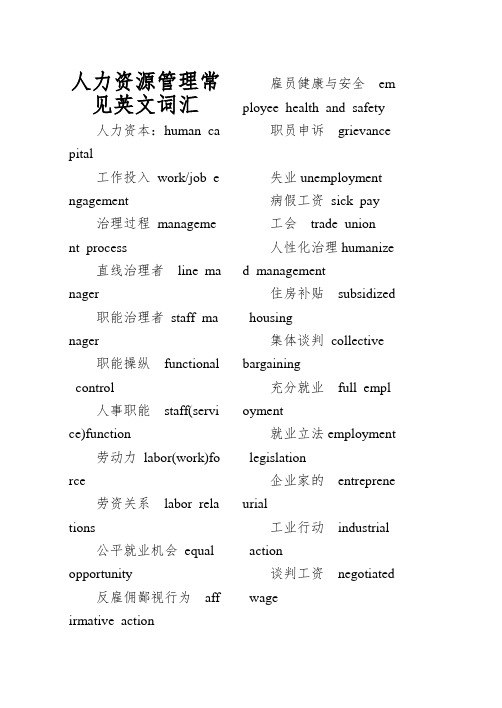
人力资源管理常见英文词汇人力资本:human ca pital工作投入work/job e ngagement治理过程manageme nt process直线治理者line ma nager职能治理者staff ma nager职能操纵functional control人事职能staff(servi ce)function劳动力labor(work)fo rce劳资关系labor rela tions公平就业机会equal opportunity反雇佣鄙视行为aff irmative action雇员健康与安全em ployee health and safety 职员申诉grievance失业unemployment病假工资sick pay工会trade union人性化治理humanize d management住房补贴subsidized housing集体谈判collective bargaining充分就业full empl oyment就业立法employment legislation企业家的entreprene urial工业行动industrial action谈判工资negotiated wage市场工资率market r ate工作分析job analysisMethods of collectin g job analysis informatio n:inteiview、questionaires 咨询卷法、observation观看法、participant dairy/log s 工作日志写实法、positi on analysis questionnaire PAQ职位分析咨询卷工作描述job descri ption工作讲明job specif ication工作承担者在职(位)者job incumbent/h older权限authority工作权限Authority o f incumbent工作标识job identi fication工作概要(综述) job summary知识、技能、能力KSA职位弱化Dejobbing扁平化组织flattene d organization工作扩大化job enl argement工作轮换Job rotati on无边界组织boundar yless organization工作丰富化job enr ichmment流程再造reengineer ing继任、接班successi on富余redundancy人员流淌turnover聘请recruitment人力资源规划及补充HR planning and recruiti ng人力资源需求pers onal need/demand人力资源供给pers onal supply(企业)内(外)部供给Supply of inside/o utside candidateMethods of predictin g employment needs:trend analysis趋势分析、rati o analsis 比率分析、 A scatter plot 散点图、usi ng computer to forcast P ersonel requirments正规教育formal edu cation行业体会industry e xperience人员调配/配置图pe rsonel replacement chart人员储备开发记录p ersonel inventory and dev elopment record人员配置staffing eq uation劳动生产率producti vity资格数据库qualific ations inventory职位空缺vacancy/ open/opening填补职位空缺fill op en positions工作公告job posting人事记录personnel record技能库skill bank继任打算succession planning申请者群an applic ant pool就业服务机构(中介) employment agency校园聘请college rec ruiting猎头公司head hunte rs/executive recruiters举荐referral上门求职walk-in网上聘请recruiting on the internet甄选selection面试interview工作申请表applicat ion form工作样本work sa mple评判中心assessment center背景调查background investigation效度validity信度reliability非定向/非结构化面试nondirective/unstructur ed interview定向/结构化面试dir ective/structured interview 评判面试appraisal interview情境面试situational interiew行为面试behavioral interview压力面试stress inte rview工作有关性面试job-related interview系列化面试serialize d interview心理面试psycholog ical interview个人面试personal in terview小组面试panel inter view集风光试mass inter view培训与开发training and development上岗培训employee orientation/orientating emp loyees培训需求training ne eds工作手册workbooks子任务subtasks低产出low output基层lower level在职者job holdersTraining methods:on-t he-job training(OJT)、模拟培训simulated training、学徒apprentlceship trainin g角色扮演role playi ng行为塑造behavior modeling企业大学corporate university企业内部开发中心i n-house development cent ers绩效评估performan ce appraisal强制分布法forced distribution method行为锚定评判尺度b ehaviorally anchored ratin g scal (BARS)维度dimension目标治理managem ent by objectives (MBO)职业生涯治理carrer management咨询专家counseling expert/consultant薪酬、补偿compens ation奖励与福利incentives and benefits酬劳remuneration薪资调查pay survey内在的intrinsic外在的extrinsic工资结构pay structu re工资等级pay grade工资范畴pay range货币的monetary差不多工资base pa y基准单位benchmark job可变工资variable p ay宽带薪酬broadbandin g小时工资hourly pay带薪休假paid time off1.人力资源治理:(Hu man Resource Manageme nt ,HRM)人力资源经理:( hum an resource manager)高级治理人员:(execut ive)职业:(profession)道德标准:(ethics)操作工:(operative em ployees)专家:(specialist)人力资源认证协会:(t he Human Resource Certi fication Institute,HRCI)2.外部环境:(external environment)内部环境:(internal en vironment)政策:(policy)企业文化:(corporate culture)目标:(mission)股东:(shareholders)非正式组织:(informal organization)跨国公司:(multination al corporation,MNC)治理多样性:(managing diversity)3.工作:(job)职位:(posting)工作分析:(job analysi s)工作讲明:(job descri ption)工作规范:(job specifi cation)工作分析打算表:(job analysis schedule,JAS)职位分析咨询卷调查法:(Management Position Description Questionnaire, MPDQ)行政秘书:(executive secretary)地区服务经理助理:(a ssistant district service m anager)4.人力资源打算:(Hu man Resource Planning,H RP)战略规划:(strategic p lanning)长期趋势:(long term trend)要求推测:(requiremen t forecast)供给推测:(availability forecast)治理人力储备:(mana gement inventory)裁减:(downsizing)人力资源信息系统: (Human Resource Informa tion System,HRIS)5.聘请:(recruitment)职员申请表:(employe e requisition)聘请方法:(recruitment methods)内部提升:(Promotion From Within ,PFW)工作公告:(job postin g)广告:(advertising)职业介绍所:(employ ment agency)专门事件:(special ev ents)实习:(internship)6.选择:(selection)选择率:(selection rat e)简历:(resume)标准化:(standardizatio n)有效性:(validity)客观性:(objectivity)规范:(norm)录用分数线:(cutoff s core)准确度:(aiming)业务知识测试:(job k nowledge tests)理交流平台!人力资源治理英文词汇高级治理人员:(execut ive)职业:(profession)道德标准:(ethics)操作工:(operative employ ees)专家:(specialist)人力资源认证协会:(the H uman Resource Certificati on Institute,HRCI)外部环境:(external enviro nment)内部环境:(internal environ ment)政策:(policy)企业文化:(corporate cultur e)目标:(mission)股东:(shareholders)非正式组织:(informal org anization)跨国公司:(multinational c orporation,MNC)工作:(job)职位:(posting)工作分析:(job analysis)工作讲明:(job description) 工作规范:(job specificatio n)工作分析打算表:(job anal ysis schedule,JAS)职位分析咨询卷调查法: (Management Position De scription Questionnaire,M PDQ)行政秘书:(executive secre tary)地区服务经理助理:(assista nt district service manage r)战略规划:(strategic planni ng)长期趋势:(long term tren d)治理人力储备:(mana gement inventory)裁减:(downsizing)人力资源信息系统:(Huma n Resource Information S ystem,HRIS)聘请方法:(recruitment methods)内部提升:(Promotion Fro m Within ,PFW)广告:(advertising)职业介绍所:(employment agency)专门事件:(special events) 实习:(internship)选择:(selection)选择率:(selection rate)简历:(resume)标准化:(standardization) 有效性:(validity)客观性:(objectivity)规范:(norm)录用分数线:(cutoff score) 准确度:(aiming)业务知识测试:(job knowl edge tests)求职面试:(employment int erview)非结构化面试:(unstructure d interview)结构化面试:(structured int erview)小组面试:(group intervie w)职业爱好测试:(vocational interest tests)会议型面试:(board intervi ew)组织变化与人力资源开发人力资源开发:(Human Re source Development,HRD)训练:(coaching)辅导:(mentoring)经营治理策略:(business g ames) 案例研究:(case study)会议方法:(conference met hod)角色扮演:(role playing)在职培训:(on-the-job training ,OJT)企业文化与组织进展企业文化:(corporate cultur e)组织进展:(organization de velopment,OD)调查反馈:(survey feedbac k)质量圈:(quality circles)目标治理:(management by objective,MBO)全面质量治理:(Total Qual ity Management,TQM)团队建设:(team building) 职业打算与进展职业:(career)职业打算:(career plannin g)职业道路:(career path)职业进展:(career develop ment)自我评判:(self-assessment) 职业动机:(career anchors) 绩效评判绩效评判:(Performance A ppraisal,PA)小组评判:(group appraisa l)业绩评定表:(rating scales method)关键事件法:(critical incid ent method)排列法:(ranking method) 平行比较法:(paired comp arison)硬性分布法:(forced distrib ution method)晕圈错误:(halo error)宽松:(leniency)严格:(strictness)反馈:(-degree feedback) 叙述法:(essay method)集中趋势:(central ten酬劳:(compensation) 直截了当经济酬劳:(direct financial compensation) 间接经济酬劳:(indirect fi nancial compensation)非经济酬劳:(no financial compensation)公平:(equity)外部公平:(external equity) 内部公平:(internal equity) 职员公平:(employee equit y)小组公平:(team equity)工资水平领先者:(pay lead ers)现行工资率:(going rate) 工资水平居后者:(pay foll owers)劳动力市场:(labor marke t)工作评判:(job evaluation) 排列法:(ranking method)分类法:(classification met hod)因素比较法:(factor compa rison method)评分法:(point method)海氏指示图表个人能力分析法:(Hay Guide Chart-pr ofile Method)工作定价:(job pricing)工资等级:(pay grade)工资曲线:(wage curve) 工资幅度:(pay range)福利和其它酬劳咨询题福利(间接经济补偿)职员股权打算:(employee stock ownership plan,ESO P)值班津贴:(shift differentia l)奖金:(incentive compensat ion)分红制:(profit sharing)安全与健康的工作环境频率:(frequency rate) 紧张:(stress)角色冲突:(role conflict) 催眠法:(hypnosis)酗酒:(alcoholism)职员和劳动关系工会:(union)地点工会:(local union)行业工会:(craft union)产业工会:(industrial unio n)全国工会:(national union) 谈判组:(bargaining union) 劳资谈判:(collective barga ining)仲裁:(arbitration)罢工:(strike)内部职员关系:(internal e mployee relations)纪律:(discipline)纪律处分:(disciplinary act ion)申诉:(grievance)降职:(demotion)调动:(transfer)晋升:(promotion行政秘书:(executive secretary)工作投入度:Work d evotion degrees后备人员:Reserve p ersonnel业务人员:Business personnel。
职工代表的选拔流程
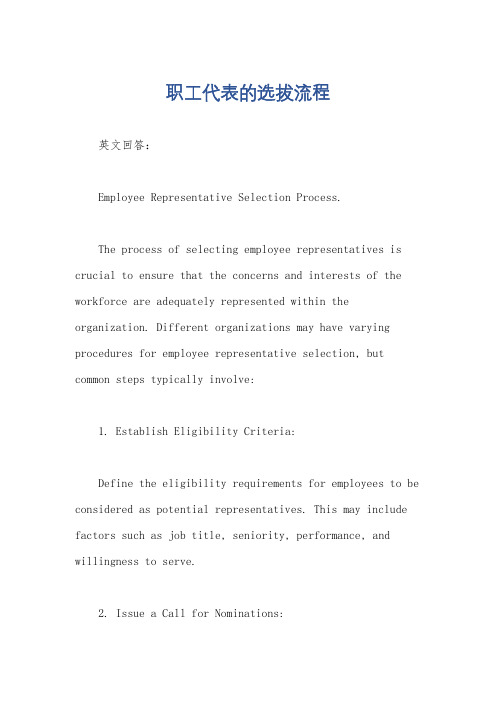
职工代表的选拔流程英文回答:Employee Representative Selection Process.The process of selecting employee representatives is crucial to ensure that the concerns and interests of the workforce are adequately represented within the organization. Different organizations may have varying procedures for employee representative selection, but common steps typically involve:1. Establish Eligibility Criteria:Define the eligibility requirements for employees to be considered as potential representatives. This may include factors such as job title, seniority, performance, and willingness to serve.2. Issue a Call for Nominations:Announce the opportunity for employees to nominate themselves or others for representative positions. Provide clear instructions on the nomination process, including deadlines and required documentation.3. Review Nominations:A designated committee or panel reviews the nominations to verify eligibility and assess the qualifications of the candidates. This may involve interviews or reference checks.4. Conduct Elections:If multiple candidates are nominated, an election is held to determine the employee representatives. Theelection process may vary depending on the organization's size and structure. Common methods include direct voting, secret ballots, or a ranked-choice voting system.5. Appoint Representatives:Based on the election results, the designated authority appoints the employee representatives. Theserepresentatives typically serve for a predetermined term, such as one or two years.6. Provide Training and Support:The newly appointed employee representatives receive training and support to enhance their effectiveness intheir role. This may include training on negotiation skills, labor relations, and organizational policies.7. Monitor and Evaluate Performance:The organization monitors the performance of the employee representatives and provides regular feedback.This helps ensure that they are effectively representingthe interests of the workforce and fulfilling their responsibilities.中文回答:职工代表的选拔流程。
劳务二手单流程及方案
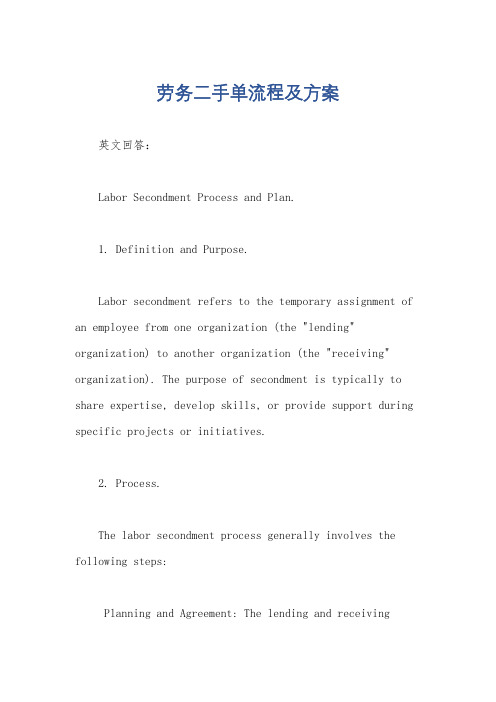
劳务二手单流程及方案英文回答:Labor Secondment Process and Plan.1. Definition and Purpose.Labor secondment refers to the temporary assignment of an employee from one organization (the "lending" organization) to another organization (the "receiving" organization). The purpose of secondment is typically to share expertise, develop skills, or provide support during specific projects or initiatives.2. Process.The labor secondment process generally involves the following steps:Planning and Agreement: The lending and receivingorganizations agree on the terms of the secondment, including the duration, scope of work, and compensation arrangements.Employee Selection: The lending organizationidentifies and selects the employee who will be seconded to the receiving organization.Contract: A written contract is drawn up outlining the terms of the secondment, such as the start and end dates, responsibilities, and performance expectations.Orientation and Training: The employee undergoes orientation and training to prepare them for their role in the receiving organization.Secondment Period: The employee works at the receiving organization under the supervision and guidance of the designated manager.Performance Evaluation: The employee's performance is regularly evaluated by both the lending and receivingorganizations.Return and Reintegration: At the end of the secondment period, the employee returns to their original role in the lending organization.3. Benefits.Labor secondment can provide several benefits for both the lending and receiving organizations:For the Lending Organization:Develops the employee's skills and experience.Maintains a connection with the employee during the secondment.Gains insights into best practices from the receiving organization.For the Receiving Organization:Accesses specialized expertise not readily available within their organization.Improves operational capabilities through knowledge transfer.Fosters collaboration and innovation.4. Plan.To ensure a successful labor secondment, the following plan should be considered:Clear Objectives: Define the specific goals of the secondment and ensure they align with the strategic objectives of both organizations.Matching Skills: Identify the employee with the appropriate skills and experience to meet the requirements of the receiving organization.Communication and Coordination: Establish clear communication channels between the lending and receiving organizations to facilitate regular updates and address any issues.Performance Monitoring: Implement a system to monitor the employee's performance and provide feedback throughout the secondment.Knowledge Transfer: Plan for the transfer of knowledge and skills between the employee and the receiving organization.Reintegration Support: Prepare for the employee's return to the lending organization by providing reintegration support and career development opportunities.5. Risk Management.To mitigate potential risks associated with labor secondment, it is important to:Comply with all applicable laws and regulations.Manage financial and contractual obligations.Protect intellectual property rights.Address legal and operational issues, such as employee status, insurance, and liability.中文回答:劳务二手单流程及方案。
公司年度优秀员工评选方案 英文版

公司年度优秀员工评选方案英文版Annual Outstanding Employee Selection ProgramObjective:The Annual Outstanding Employee Selection Program aims to recognize and reward exceptional performance, dedication, and contributions of our employees throughout the year. This program is designed to motivate and inspire a culture of excellence within our organization.Selection Criteria:Performance Excellence:Employees will be evaluated based on their outstanding performance in achieving individual and team goals, demonstrating exceptional skills, and contributing to the overall success of projects.Leadership and Initiative:Leadership qualities and proactiveness in taking initiative will be considered. Individuals who inspire and motivate their colleagues, exhibit strong leadership skills, and contribute innovative ideas will be recognized.Commitment to Company Values:Employees who consistently uphold and embody the core values and principles of our company will receive special consideration. This includes a commitment to integrity, teamwork, and continuous improvement.Customer Satisfaction:Employees who have significantly contributed to enhancing customer satisfaction through excellent service, problem-solving, and exceeding customer expectations will be acknowledged.Nomination Process:Self-Nomination:Employees are encouraged to submit self-nominations outlining their achievements, projects, and contributions to their respective departments.Peer Nominations:Colleagues may nominate their peers for outstanding contributions and achievements. Nominations should include specific examples of howthe nominee has positively impacted the team or projects.Supervisor Nominations:Supervisors will have the opportunity to nominate outstanding employees based on performance evaluations and notable contributions to the organization.Evaluation Panel:An impartial evaluation panel, consisting of representatives from various departments, will review and assess the nominations. The panel will consider the nominees' achievements, leadership qualities, and commitment to company values.Awards and Recognition:Selected outstanding employees will be honored with awards, certificates, and public recognition during a special ceremony. In addition, they may receive additional benefits, opportunities for professional development, or other incentives.Communication:The program details, nomination process, and updates will be communicated to all employees through company-wide announcements,emails, and internal communication channels.Conclusion:The Annual Outstanding Employee Selection Program aims to foster a culture of excellence, celebrate our employees' achievements, and motivate everyone to strive for continuous improvement. Through this program, we recognize and appreciate the dedication and outstanding contributions of our exceptional team members.Thank you for your commitment to excellence.[Company Name] Management Team。
- 1、下载文档前请自行甄别文档内容的完整性,平台不提供额外的编辑、内容补充、找答案等附加服务。
- 2、"仅部分预览"的文档,不可在线预览部分如存在完整性等问题,可反馈申请退款(可完整预览的文档不适用该条件!)。
- 3、如文档侵犯您的权益,请联系客服反馈,我们会尽快为您处理(人工客服工作时间:9:00-18:30)。
Employee Selection is the process of putting right men on right job. It is a procedure of matching organizational requirements with the skills and qualifications of people. Effective selection can be done only when there is effective matching. By selecting best candidate for the required job, the organization will get quality performance of employees. Moreover, organization will face less of absenteeism and employee turnover problems. By selecting right candidate for the required job, organization will also save time and money. Proper screening of candidates takes place during selection procedure. All the potential candidates who apply for the given job are tested.
But selection must be differentiated from recruitment, though these are two phases of employment process. Recruitment is considered to be a positive process as it motivates more of candidates to apply for the job. It creates a pool of applicants. It is just sourcing of data. While selection is a negative process as the inappropriate candidates are rejected here. Recruitment precedes selection in staffing process. Selection involves choosing the best candidate with best abilities, skills and knowledge for the required job.
The Employee selection Process takes place in following order-
1.Preliminary Interviews- It is used to eliminate those candidates
who do not meet the minimum eligiblity criteria laid down by the organization. The skills, academic and family background,
competencies and interests of the candidate are examined during preliminary interview. Preliminary interviews are less formalized and planned than the final interviews. The candidates are given a brief up about the company and the job profile; and it is also
examined how much the candidate knows about the company.
Preliminary interviews are also called screening interviews.
2.Application blanks- The candidates who clear the preliminary
interview are required to fill application blank. It contains data record of the candidates such as details about age, qualifications, reason for leaving previous job, experience, etc.
3.Written Tests- Various written tests conducted during selection
procedure are aptitude test, intelligence test, reasoning test, personality test, etc. These tests are used to objectively assess the potential candidate. They should not be biased.
4.Employment Interviews- It is a one to one interaction between the
interviewer and the potential candidate. It is used to find whether the candidate is best suited for the required job or not. But such interviews consume time and money both. Moreover the competencies of the candidate cannot be judged. Such interviews may be biased
at times. Such interviews should be conducted properly. No
distractions should be there in room. There should be an honest communication between candidate and interviewer.
5.Medical examination-Medical tests are conducted to ensure physical
fitness of the potential employee. It will decrease chances of employee absenteeism.
6.Appointment Letter-A reference check is made about the candidate
selected and then finally he is appointed by giving a formal appointment letter.。
